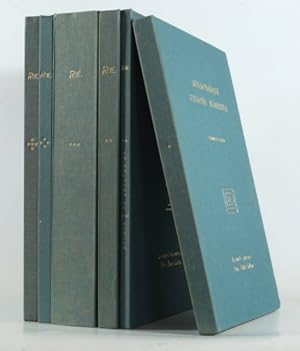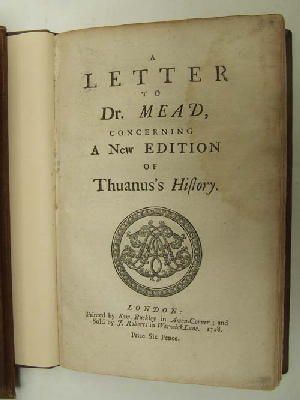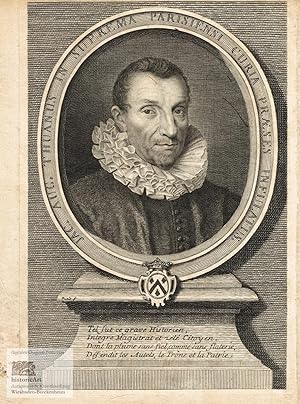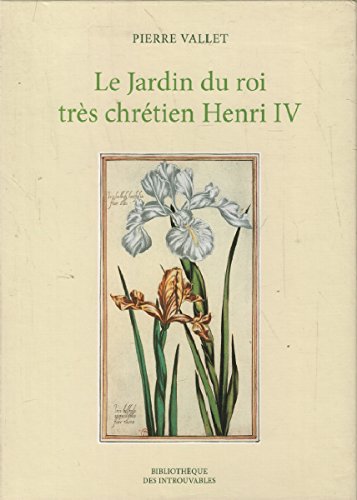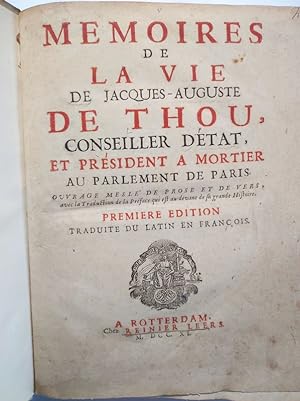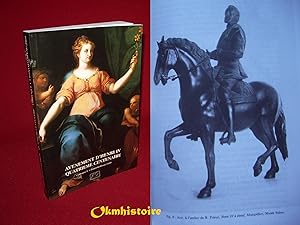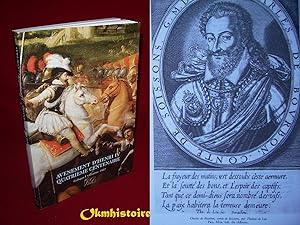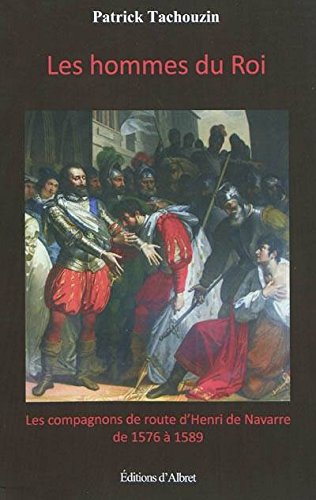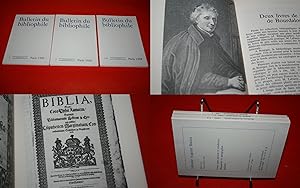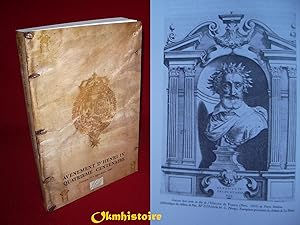First Edition (63 results)
Product Type
- All Product Types
- Books (61)
- Magazines & Periodicals (1)
- Comics
- Sheet Music
- Art, Prints & Posters (1)
- Photographs
- Maps
-
Manuscripts &
Paper Collectibles
Condition
- All Conditions
- New
- Used
Binding
Collectible Attributes
Free Shipping
Seller Location
Seller Rating
-
De triangulis planis et sphaericis. (.) quae extructa est à Ptolemeaeo & Copernico de Revolutionibus orbium caelestium. [Avec : ] - Problematum astronomicorum et geometricorum sectiones septem. [Avec :] - In Ptolemaei magnam compositionem, quam almagestum vocant, libri tredecim
Published by (Heinrich Petri & Peter Perna), Basel, 1561
First Edition
*** Première édition donnée par Daniel Santbech de cet ouvrage de Regiomontanus. Il l'a revu et commenté à la lumière des découvertes de Copernic. Rédigé en 1464, ce texte n'a été publié pour la première fois qu'en 1533 à Nuremberg. Illustré de très nombreux bois gravés dans le texte. Relié à la suite : - SANTBECH. Problematum astronomicorum et geometricorum sectiones septem. Basileae, Per Henrichum Petri, et Petrum Pernam, 1561. In-folio de (20), 294, (2) pp. Première édition. Une suite de l'ouvrage précédent, qui traite des applications pratiques. La plus grande partie est consacrée à l'astronomie et ses instruments. L'auteur traite aussi des cadrans solaires, de géographie, de navigation, d'arpentage, de balistique. Le mathématicien et astronome Daniel Santbech était hollandais. En 1651, Riccioli a donné son nom à un cratére de la Lune. Relié avec : - REGIOMONTANUS, PEURBACH. In Ptolemaei magnam compositionem, quam almagestum vocant, libri tredecim. Conscripti à Joanne Regiomontano . ; in quibus vniversa doctrina de coelestibus motibus, magnitudinibus, eclipsibus &c., in epitomen redacta, proponitur. Nuremberg, J. Berg, U. Neuber, 1550. In-folio de (116) ff. Troisième édition de la première traduction complète, donnée par Peurbach et Regiomontanus à partir d'un manuscrit grec découvert à Byzance. (La première Venise, 1496, la 2e Bâle, 1543). Titre en noir et rouge et nombreux bois gravés dans les marges. Exemplaire dans une magnifique reliure en maroquin aux armes et au chiffre de JACQUES-AUGUSTE DE THOU. Ce volume porte ses seules armes et a donc été relié avant 1587, date de son premier mariage. Jacques-Auguste de Thou (1553-1617) commença sa collection vers 1573. Ce fameux bibliophile a rassemblé des milliers de livres sur tous les sujets, mais, il est cependant rare de rencontrer un livre de science portant ses armes. Celui-ci a été particulièrement bien relié, dans un maroquin précieux, probablement de Turquie. *** In-folio de (8), 146, (38) pp. Maroquin citron, dos à nerfs orné du chiffre de Thou, plats aux armes du même, encadrements dorés, (Reliure de l'époque.) - - - - - - - - - - - - - - - - - - - - - - - - - - - - - - - - - - - - - - - - - - - - - - - - - - - - - - - - - - - - - - - - - - - - * Copy from the famous library of Jacques Auguste de Thou, in a splendid morroco binding. First edition given by Daniel Santbech. He revised and augmented this work by Regiomontanus, according to Copernicus' discoveries. Written in 1464, it was published for the first time in 1533 in Nuremberg. "The first systematic treatise on plane and spheric trigonometry to be published in Europe. (.) With 'De triangulis' trigonometry was established as an independent discipline. Regiomontanus' original purpose, however, had been to furnish astronomers with a mathematical technique essential for their studies, and in this De triangulis had a success perhaps greater than its author could have dreamed of. For in 1539 Georg Joachim Rheticus presented a copy of the work's 1533 edition as a gift to Copernicus. The great astronomer had already written the trigonometrically-based portion of his De Revolutionibus without knowledge of his predecessor's treatise. After reading the new book, Copernicus modified the presentation of several of his own indispensable theorems by inserting two leaves in the manuscript of the De Revolutionibus. Hence, Rheticus' remark that Regiomontanus began the reconstruction of astronomy that Copernicus completed takes on a fuller meaning." (Rose, The Italian Renaissance of Mathematics). Bound with: - SANTBECH. Problematum astronomicorum and geometricorum sectiones septem . Basileae, Per Henrichum Petri, and Petrum Pernam, 1561. First edition. A continuation with practical applications of the previous work. Most of the book is devoted to astronomy and its instruments. The author also deals with sundials, geography, navigation, surveying, ballistics . Daniel Santbech (fl. 1561) was a Dutch mathematician and astronomer. In 1651, Riccioli gave his name to a crater on the Moon. Both volumes are illustrated with many woodcuts in text. Bound with: - REGIOMONTANUS, PEURBACH. In Ptolemaei magnam compositionem, quam almagestum vocant, libri tredecim. Nuremberg, Apud Ioannem Montanum & Ulricum Neuberum, 1550. Third edition of the first complete translation of Ptolemy, given by Peurbach and Regiomontanus from a Greek manuscript discovered in Byzantium. (The first Venice, 1496, the 2nd Basel, 1543). Title in black and red and many wood cuts in the margins. Contemporary yellow morroco, spine gilt with nerves, arms of de Thou gilt on boards. Splendid copy with a distinguished provenance. - -.
-
Deipnosophistarum libri XV (edited by Isaac Casaubon; tr. J. Dalechamps). [Geneva, Henri and Paul Estienne, for] Jérôme Commelin, 1598
Publication Date: 1598
Seller: Maggs Bros. Ltd ABA, ILAB, PBFA, BA, London, United Kingdom
First Edition Signed
Commelin's device on title-page, Estienne's ?Dolphins? headpiece at beginning of text; greek and latin in double columns. Folio (350 x 222mm). [2]ff 702p, [25]ff (blank leaf after title-page and blank leaf nnn4). Contemporary French red morocco, covers with triple gilt fillet and central arms of Jacques-Auguste de Thou (a chevron sable and three gadflies) and Marie de Barbançon, (three lions rampant), spine gilt in compartments with title and their ?IAM? monogram [Olivier 216 fer 5 & fer 6], gilt edges (a few minor marks). The first edition of Athenaeus' classic work of gastronomy to be edited by the great scholar Isaac Casaubon, and also the first to carry a Latin translation alongside the Greek text, printed by the Estiennes in Geneva for Commelin. This copy is from the library of the distinguished French bibliophile Jacques-Auguste de Thou and the superb red morocco binding holds the arms of de Thou and his first wife Marie de Barbançon-Cany, who died in 1601, making the binding strictly contemporary. It is rare to find a folio red morocco binding for de Thou in such an excellent state of preservation. As noted by Schreiber, ?Casaubon has augmented and corrected the text (as printed in the Aldine 1514 and Basle 1535 editions) from manuscripts at his disposal; the Latin translation by Dalechamps is accompanied by marginal annotations.? The Animadversiones announced on the title-page was not published with this edition, following the death of Commelin, but first printed at Lyon in 1600. ?Casaubon's famous edition of Athenaeus, which bears the imprint of Commelin, and is variously listed as having been printed in Heidelberg, Lyon, or Paris, was actually printed in Geneva, at Henri Estienne's press, under the supervision of Paul Estienne. This is simply attested by Casaubon himself, in several letters written by him from Geneva to Commelin and other correspondents? (Schreiber). This edition was issued with the title-page variously found dated 1597 or 1598. Athenaeus is this the oldest cookbook known to us, from c. 200 CE, and describes a series of dinner conversations held by a group of learned men hosted in Rome by Larensius. The descriptions of banquets cover the the correct adornments needed according to classical taste, including a great deal of information on table settings, costume, music, songs, dance and even courtesans. Wine is fully explored, as well as discussing the wines of Italy, Greece and Egypt, ?le livre second débute par une description détaillée de l'origine, de la nature, des propriétés et des principaux effets du vin? (André Simon), and discussion ranges from drinking cups to drunkenness. Also described are varieties of bread, pastries, animals, birds, fish, fruit and vegetables, as well as famous gastronomes and cooks. As noted by Gulick, it is also ?in some respects. the most important work of later antiquity? as Athenaeus quotes over 1000 authors and over 10000 lines of verse, many from ancient sources that are now lost to us. Had it not survived ?our knowledge of classical Greek literature and its reception in the Hellenistic and Roman periods would have been immensely poorer? Provenance: 1. Jacques-Auguste de Thou (1553-1617) and his first wife, Marie de Barbançon-Cany, with their arms. The bulk of De Thou?s magnificent library was sold by his heirs in 1680 to Jean-Jaques Charron, Marquis de Menars (1644-1718), and then in 1706 acquired by Armand Gaston, Cardinal de Rohan (1674-1749), it then passed to Charles de Rohan, Prince of Soubise (1715-87) and holds the shelfmarks of the Hôtel de Rohan in Paris, inside front cover, 2.P.1.j.9 and 2.C.P.T.1.j.n.9, (Chambre Parquette, tablette 1, shelf j, volume 9). Lot 5626 in the sale of the Rohan-Soubise library, Paris, January 1789. 2. There is a 19th century note in English on the flyleaf, signed L.D., about the publication of this volume. 3. Maggs Bros Ltd, Catalogue 395 (1920), no. 1024. 4. From the library of the Greek economist and politician Spyros Loverdos (1874-1936), with bookplate of the Spyros Loverdos Foundation, and their library markings at rear. Some light browning due to paper quality. VD16 A4005 (assigned to Heidelberg). Schreiber Estienne 286 (1597 edition). Hoffmann I, 396. Simon Bibliotheca Bacchica 58 & 59 (1514 & 1556 eds) Bibliotheca Gastronomica 145 (1657 ed).
-
Praecepta genethliaca, sive de prognosticandis hominum nativitatibus [with] Horarum Natalium Centuria Una, sive Narratio Historica [and] Astrologia Sacra
Published by Wolfgang Richter, Johann Theobald Schönwetter and Konrad Meul [and] Elisabeth Angermaier, 1607
Seller: Sokol Books Ltd. ABA ILAB, London, United Kingdom
Book First Edition
Hardcover. Condition: Good. 1st Edition. FIRST EDITIONS. 4to, 3 works in one, pp. (viii) 227 (i); 124; (viii) 64. Roman letter, astrological symbols, woodcut floriated and historiated initials, decorated headpieces, tailpieces and typographical ornaments. First t-p within ornate engraved border, several astrological tables and calculations in first work, 100 horoscope diagrams in second. Light age yellowing, old repair to one lower outer corner, small paper flaw hole to one fol. affecting a few words, small rust mark to one lower blank margin. A very good copy, beautifully bound in contemporary French morocco, gilt arms of Jacques Auguste de Thou (1553-1617) and his second wife Gasparde de la Chastre to covers, spine with gilt raised bands, de Thou s and de la Chastre s monogram and titles gilt in compartments, a.e.g. Modern bookplate C.M.P of Charles-Maurice de Pourtalès. The elegant armorial binding bears the arms of the French politician, historian and bibliophile Jacques Auguste de Thou (1553-1617) joined with those of his second wife, Gasparde de la Chastre. The monogram contains their initials interlaced. De Thou served Henry III and Henry IV as councillor of state, became director of the royal library in 1593 and president of the Parliament of Paris in 1595. His outstanding library, famous among contemporaries and open to scholars and foreigners, was one of the most important private libraries of the end of the 16th century, for the quality of its content and its size (it contained an estimated number of 9,000 volumes in 1617). Remarkably, for the first time, the volumes were systematically bound in rich armorial bindings, changing according to the marital status of their owner. After de Thou s death, the library was inherited by his son Jacques-Auguste II de Thou in 1642. The volume contains excellent copies of the first editions of three fascinating works on astrology. The first, Praecepta genethliaca is a treatise by the reformed theologian Christoph Pezel (1539-1604). It examines the twelve astrological houses of the horoscope (corresponding to the twelve signs) - with particular focus on the sixth, concerned with illness and it contains a section on the history of astrology and prediction. The engraved title page, possibly realised by Theodore de Bry or one of his school, has been defined as one of the most delightful in the early astrological books [ ] Beginning at the upper left and following around counter-clockwise are small vignettes showing first Mars, the planet and the two signs Aries and Scorpio, which it rules; next is Jupiter with the signs Sagittarius and Pisces; then Saturn with Aquarius and Capricorn. Centered below is an interesting heraldic device supported by angels; then comes the Moon with Cancer; followed by Mercury with Gemini and Virgo. At the upper right is Venus with Taurus and Libra. The design at the center above is the Sun accompanied by the sign of Leo. (Hall) The second work is the physician Johann Rudolph Camerarius s (b.1588) attack against false astrologers. It illustrates the principles of the true science of astrology through 100 horoscope diagrams identifying the celestial birth coordinates of (mainly German) royal, aristocratic and political figures as well as unknown people who had been his patients and even his own family members. Interesting is the case of two twins who died shortly after birth, in 1606, due to epilepsy. The third work is a collection of five academic Orationes , Disputationes and Quaestiones on astrology, astronomy and superstition, discussed at the University of Ingolstadt in 1514. The academic debates were chaired by the Austrian Jesuit theologian Adam Tanner (1572-1632), author of the first and third orations. The second oratio is by the theologian Otho Heinrich Bachmair against judicial astrology, and a quaestio by Friedrich Pirchinger discusses whether astronomical phaenomena are to be considered prodigia .
-
Response au livre publie par le Sieur Evesque Evreux, sur la conference tenue a Fontaine-Bleau
Published by A.Saumur, par Thomas Portau, 1600
Seller: Stephen Butler Rare Books & Manuscripts, Castlethorpe, PROVI, United Kingdom
Book First Edition
Hardcover. Condition: Fine. 1st Edition. Brown goatskin over pasteboard with gold tooling over both covers and spine. A single gold fillet provides the outer border on each cover. Double gold fillets surround and separate two inner borders. The outer of these two borders consists of a gold small flower roll, the inner is made-up of leaf and palm stamps. The central panel is filled with small gold oval stamps formed of leaves arranged in rows. At the centre of each oval is either a knot, a two leaf flower, a four leaf flower, a leaf and acorn, a thistle or a feather. Each oval is divided from the one below by a circle, and there are gothic S s in the spaces between ovals. Small leaf stamps are placed between the ovals on the outer edges of the panels. In the centre of each panel is a larger version of the gold oval stamp, but with a blank centre to it. Front and back covers are decorated in a similar fashion but the back cover has a hole burnt in the leather at its centre. The spine is flat with a panel formed of a small oval tools three abreast in rows, surrounded by double gold fillets, a border of the small flower roll and more double gold fillets. At the head and tail of the spine are two rows of hatching separated by a single gold fillet. The remains of the headbands are orange and green. There is a single gold fillet around the edges of the boards. The paper edges are gilt and gauffered with traces of paint. The text has been ruled throughout in red ink. The cords of this binding are laced in and pasted down on the inside of the boards under the pastedowns. The text of this work is lacking the signature A, comprising 16pp; perhaps due to censorship (see below). Provenance: There is an inscription on the title page, Donfait a moy Paul Collez Mespin, 1675 . Paul Coulletz (Huguenot pastor active in the pays messin, born Metz, 1639), inscription dated 1675; Law Society, armorial bookplate Jun 05, 2013 - Jun 05, 2013 Highlights from the Mendham Collection: The property of the Law Society of England and Wales Binding: This binding is reminiscent in style to a binding made in 1586 for Jacques-Auguste de Thou, but the binding described here must have been completed after 1602. The binding is very similar in style to those commissioned by Pietro Duodo (1554-1611) in Paris at the turn of the seventeenth century. The tool used for the border of leafy sprays is identical (see Esmerian catalogue, nos 59-61) and it is indeed used in a similar and not quite symmetrical fashion; it is most likely that this binding comes from the same Parisian workshop as Duodo's (see Hobson, Italian and French 16th-Century Bookbindings, nos 69 and 74, the latter of which also has blank ovals for arms to be added). The individual tools are those found on fanfare bindings, but the overall effect is different. Philippe de Mornay, the author of this work, had his own books bound in fanfare bindings (see Hobson, Les reliures à la fanfare, no. 122). Philippe de Mornay (1549-1623), a French Protestant Hugenot, endured the tumult of the Wars of Religion. Born in Buhy, he embraced Protestantism after his father's death. He studied law in Heidelberg and Padua. As a Huguenot apologist, he wrote prolifically, escaping the St. Bartholomew's Day Massacre and finding refuge in England. Mornay became a key figure in Henry IV's circle, but was disheartened by the king's conversion to Catholicism. He dedicated his later years to the Huguenot cause, participating in the Synod of Dort despite opposition from Louis XIII. Mornay died in retirement at La Forêt-sur-Sèvre, mourning the loss of his son and wife. He founded the Hugenot Academy at Saumur in 1593. The present work is his response to a publication by the diplomat and Baroque poet Jacques du Perron (1556-1618). In his book, the Reformation, published in 1598, Perron criticized the use and teaching of the holy sacrament of the Eucharist in the ancient church. In a public dispute in Fontainebleau in May 1600, Mornay opposed his opinion, which ultimately ma.
-
Hieracosophiou, sive de re accipitraria libri tres.
Published by Paris, King s Printer "in officina Robert Estienne", 1584., 1584
Seller: Antiquariat INLIBRIS Gilhofer Nfg. GmbH, Vienna, A, Austria
First Edition
4to (220 x 150 mm). (4), 95, (13) pp. Half vellum (ca. 1892). First complete edition, in the original Latin, of one of the most famous and longest of De Thou's poems, a didactic verse in about 2780 hexameters devoted to hunting with falcons and other birds of prey, composed in three "libri" and addressed to François, Duke of Alençon, Anjou and Brabant (1555-84), the youngest son of the late King Henri II and Catherine de' Medici, and brother of the reigning King Henri III. It is the first major Latin work on the subject of falconry. Book 1 discusses the various kinds of birds of prey used in falconry and how to choose one, book 2 discusses their care and feeding, training and the practice of hunting with them, and book 3 discusses their medical care. De Thou anonymously published an advance version of books 1 and 2 at Bordeaux in 1582, but his own correspondence indicates that he had only a few copies of that edition printed, primarily to send them to colleagues (including Pierre Pithou, Claude Dupuy and Joseph Scaliger) for their corrections and suggestions. Harvard University has the only known copy of that edition, and De Thou decided not to complete it but instead to make extensive revisions and add the third book for the present edition, beautifully printed by the King s Printer in Paris. The poem ends on p. 95, with the next page containing an "important" (Harting) note about the various kinds of birds of prey used for falconry and giving their French and Latin names. The last six leaves contain Thou s 11-page letter to Philippe Huralt (1528-99), French chancellor under King Henri III, on the subject of falconry, and on the last page the corrigenda. Falconry was so popular in France from the reign of François I to that of Louis XIII that it can be considered the national pastime of the French nobility, as well as the prominent clergy, military figures and politicians in that period, 1515-1643. - With a modern armorial bookplate of the Verne d Orcet family, whose great library on the subject of hunting was begun ca. 1900. Formerly side-stitched through 4 holes, B1 and B4 no longer conjugate but still securely attached, a faint marginal stain in the lower outside corner of the last few leaves and the foot of the title-page slightly thumbed, but still in very good condition and with large margins. The outer free endleaf at front and back slightly browned, but the binding also very good. - Adams T 657. Harting 306. Souhart 461. De Smet (ed.), La fauconnerie à la Renaissance: le Hieracosophion, passim (a critical edition and French translation with extensive commentary). De Smet, Thuanus: the making of Jacques-Auguste de Thou, pp. 51-66. French vernacular books 88799. Kinser, Works of Jacques Auguste de Thou (1966), 7 (pp. 205-207). Sotheby s (Marcel Jeanson coll.) 28 Feb. to 1 March 1987, lot 560. Thiébaud 897. USTC 171837. Cf. Schwerdt, p. 261 (1582 & 1587 eds.).
-
Jacobi Augusti Thuani HISTORIARUM SUI TEMPORIS pars prima
Published by Parisiis (Paris): Apud viduam Mamerti Patissonii typographi Regii (La veuve de Mamert Patisson, imprimeur du Roi). In officina Roberti Stephani (Robert Estienne), 1604, 1604
Seller: Cole & Contreras / Sylvan Cole Gallery, Sitges, BCN, Spain
First Edition
FIRST EDITION OF THOU'S HISTORY OF THE 16TH CENTURY, A MASTERPIECE OF FRENCH HISTORIOGRAPHY. 18, 684, 36 pp., complete. Jacques-Auguste de Thou (1553-1617), was one of the great statesmen and scholars of his time, and the Historiarum is his most important work. THIS IS THE TRUE FIRST EDITION, printed folio (another edition, in two volumes 8vo--with some large-paper copies printed 4to--was published later the same year). Moreover, the TITLE-PAGE IS IN THE FIRST STATE, which is exceedingly rare. Beautifully printed by Robert Estienne (1559-1630), with the title in red and black and attractive woodcut head- and tail-pieces throughout. Folio. Beautifully bound in recent quarter vellum and marbled boards. FINE AND BRIGHT, both inside and out, with excellent margins and bright white paper. Peignot II, 159 (pointing out that this work was suppressed from the moment of publication). An outstanding copy of a rare and important book: the only other copy I have located of the first edition with the first-state title-page is the Oxford copy.
-
De Sacra Commvnione Christiani Popvli in Vtraque panis & vini specie
Published by G. I Cervicornus], [Cologne, 1564
Seller: Bruce McKittrick Rare Books, Inc., Narberth, PA, U.S.A.
First Edition
First Edition. Cassander sought common ground in the tenets and teachings of the early church to foster the reunification of Catholics and Protestants. Here he takes up the Eucharist, emphasizing Christ's sacrifice for all believers and arguing that both Protestants and Catholics receive the sacrament's spiritual benefits. But he stopped short of asserting the veracity of transubstantiation, which rendered him suspect to Catholic authorities and ultimately landed this on the Index of Prohibited Books. Historian and bibliophile, JACQUES-AUGUSTE DE THOU OWNED, READ, AND COMMENTED FAVORABLY ON CASSANDER. Shortly before his death, de Thou (1553-1617) asked for Cassander's manuscripts to be sent from Leiden to him in Paris. Jean-Jacques Charron, marquis de Ménars (1643-1718), purchased de Thou's library. In 1706, Ménars sold his collection to Cardinal Armand de Rohan-Soubise (1674-1749), who added his shelfmark to the front pastedown. However, the cardinal apparently disposed of this copy, which entered the Colbert family library (title inscription, dispersed in 1728). No example in American collections. In nice condition, 19th-century blue stamp of hh, French bookticket on rear pastedown. Catalogus bibliothecæ thuanæ (1704) 82; Bibliotheca Colbertina (1728) 13336; VD 16 C 1402 Contemporary gilt-ruled vellum with the bachelor arms of Jacques-Auguste de Thou on the panels and his small cipher in the gilt-ruled spine compartments (O-H-R 216, fers 2 & 3 variant), gilt-lettered spine title, all edges gilt, four purple silk ties (replacements).
-
Slovo pokhvalnoe velikomu gosudariu Borisu Fedorovichu Godunovu [Eulogy to the Great Tsar Boris Fedorovich Godunov]
Published by [Akad. Nauk], Sanktpeterburg,, 1773
Book First Edition
From Catherine the Great's library --- First edition in Russian of this rare work, with great provenance: presumably from the library of Catherine the Great, with the manuscript shelfmark in the hand of her librarian Aleksandr Luzhkov, later in the famous Smirdin Library and the Fekula collection. Of all the Russian emperors, Catherine II was undoubtedly the most passionate bibliophile: by the end of her reign, her library counted around 40,000 volumes, uniting collections of her husband Petr III, Diderot, Voltaire, Marquis of Galiani and the historian Mikhail Shcherbatov. To bring order to her expanding collection, she invited in 1771 an Honorary Member of the Imperial Academy of Sciences, Aleksandr Ivanovich Luzhkov (1754-1803), who later became the principal keeper of the Hermitage library, antiquities and jewels until his retirement in 1796. Luzhkov was the first to arrange books according to their headings instead of their acquisition date as it was done earlier: "For this purpose, he tore the notebooks, in which the books had been already listed, into strips, classified them according to their contents and, having glued them to the sheets of paper on which the name of the department of literature was written, he gave them new numbers" (Pavlova, our translation here and below). For Luzhkov's convenience when cataloguing, these new numbers could be therefore often indicated on the books themselves, like on this copy according to the catalogue of the great collector Paul Fekula. This copy joined later the celebrated lending library of Aleksandr Smirdin (1795-1857), Pushkin's publisher and a leading figure of the bookselling world of Russia's so-called Golden Age of literature. Smirdin's large lending library, reaching about 50,000 volumes, turned out to be a high spot of of Russian bibliography too: its extensive printed catalogue, published in 1828, with additions until 1856, is considered "the most valuable bibliography of the history of Russian 18th and 19th century books" (Tartakovskii). It was often the only list of Russian books available to foreigners, and served for example as a guide for the British Museum's acquisitions and development of Russian holdings in the 19th century. Fidler's lifetime eulogy to Tsar Boris Godunov (1552-1605) was first published in Latin in Königsberg (nowadays Kaliningrad) in 1602/1603 as Constantini Fiedleri oratio luculenta in Borissum Godunovium. Very rare, this Latin text wasn't published again until this first Russian edition, translated by Sergei Voronov and dedicated to the aristocrat Aleksandr Viazemskii (1727 93), Catherine's trusted dignitary. Such a reedition of a historical text -by the most prestigious State press- is very representative of a movement in Russian publishing under Catherine the Great, when many works of the 17th and early 18th century appeared again, whether famous texts or secondary ones, developing in a larger scale a stronger conscience of national identity and history. Godunov's reign was highlighted by the beginning of Russia's rapprochement with the West, and "the gratitude of foreigners to the Tsar's favours," notes Nikolai Karamzin in his famous History of the Russian State, "did not remain fruitless for his fame: a scholarly man, Fidler, a resident of Konigsberg (brother of one of Godunov's physicians [Kasper Fidler]), composed a word of praise for him in Latin in 1602 which was read in Europe" - including the important French book collector Jacques-Auguste de Thou. Glorifying tsarist autocracy, Fidler enumerates Godunov's virtuous qualities: his fatherly care for his subjects, gentleness, mercy, love of enlightenment and favour for people of learning. He does not forget to mention his gratitude for his brother Kaspar's advantageous position at the court and even suggests that Godunov deserves the title of "Augustus" more than all previous Russian sovereigns. Both Latin and Russian editions are extremely rare: we could not trace any other copy of this Russian edition at auction in and outside Russia. Although we could find some physical copies in Russia and one in Azerbaijan (National Library), there is apparently none other in Western Libraries. A second Russian edition was published in 1787 and is more common. Provenance: Catherine II (shelf mark '179'); Alexander Smirdin (both early and later bookplate toi upper pastedown); Rossica bookshop (booklabel); Paul M. Fekula (num. 1650 in his catalogue; sold Christie's London in 2006, to:); Pr. Philip Longworth (1933-2020, historian, writer and book collector, esp. on Russian history). Physical description:Octavo (18.5 x 11 x cm). 70 pp. incl. title and dedication. Contemporary marbled wrappers. Condition:Wrappers lightly rubbed, spine chipped and a bit worn, with repairs, title a tiny bit dirty with a couple of small spots, otherwise an excellent example internally. Bibliography:Bitovt 1788; Fekula 1650 (this copy); Smirdin 6512 (this copy); Sopikov 10832; Svod. Kat. 7771; Boris Tartakovskii. Sovetskaia istoricheskaia entsiklopediia. V 16 tomakh. Sovetskaia entsiklopediia, Moskva, 1973 1982, Vol. 13; Nikolai Karamzin, Istoriia Gosudarstva Rossiiskogo, Moskva, 1989, Kn. III, t. XI; Zaitseva I. Tsarskoselskaia biblioteka Ekateriny II, Gos. muzei-zapovednik "Tsarskoe selo"; Zhermena Pavlova, Imperatorskaia biblioteka Ermitazha. 1762-1917. 1988.
-
[Greek title:] Epistolarum amplius mille ducentarum libri tres.accessit Latina.Iacobi Billii.Eiusdem Billii Sacrarum Observationum libri duo
Published by G. Chaudière, Paris, 1585
Seller: Bruce McKittrick Rare Books, Inc., Narberth, PA, U.S.A.
First Edition
EDITIO PRINCEPSof two thirds of Isidore of Pelusium's letters, among the largest epistolary collections of early monasticism. The remaining letters were published in two supplements, twenty and forty years later, respectively. Isidore addressed Emperor Theodosius II about tax relief and was on a first-name basis with bishops, local monks, common soldiers and professionally literary elites. This correspondence treats Greek authors, rhetoric, Scriptural commentary, government, women, disease, Jews, sex and seduction, predestination, heretics - in short "the vicissitudes of ecclesiastical, monastic, civic and intellectual life in a newly Christianized Roman Empire" (Larsen). It is a major source for early 5th-century social customs and political and church affairs. Isidore was educated in Alexandria, taught, became a monk, and, in 408, definitively retired to the desert outside Pelusium. A specialist in Church Fathers, Jacques de Billy (1535-81) edited the volume and supplied the Latin translation. He relied on three manuscripts, foremostly the 13th-century codex, then in the possession of Catherine de' Medici (Medic. Reg. 2357 = Parisinus gr. 832), which preserves the first twelve hundred thirteen of Isidore's nearly two thousand letters. He also used a copy, lent by Card. Sirleto, based on the oldest surviving manuscript (Ottoboni gr. 341, dated c. 985) and a truncated version of the text given him by Maillé de Brézé. The volume's second part, forty-seven short essays on the Greek Church Fathers, secured Billy's scholarly fame. In good condition, (one blank margin repaired, some minor browning), from the distinguished collections of J.A. de Thou (Catalogus 34), J.J. Charron marquis de Ménars, A.-G. Rohan, Chas. de Rohan prince de Soubise (Catalogue (1788) 834), J. & J.H. Thorold (Syston Park.Catalogue (1884) 1025), Lord Amherst (Hand-List 599), Michael Tomkinson (1841-1921) and the Loverdos Library with their markings. Larsen, "The Letter Collection of Isidore of Pelusium" in Late Antique Letter Collections edd. Sogno et al. 286-99; Isidorus Pelusiota, Lettres ed. & tr. Évieux I: 9-18, 50-119; Choat, "The Epistolary Culture of Monasticism between Literature and Papyri" in Cistercian Studies Quarterly 48 (2013) 227-37; Hoffmann, Bibliographisches Lexicon der gesammten Litteratur der Griechen II: 469; Cioranesco 4021. Contemporary olive gilt-ruled morocco (corners bumped, light scuffs, faded) WITH THE BACHELOR ARMS OF JACQUES AUGUSTE DE THOU and his largest cipher in the gilt-ruled spine compartments (O-H-R 216, fers 1 & 3), all edges gilt.
-
Bibliotheca Bigotiana seu catalogus librorum . .
Published by J. Boudot, C. Osmont, G. Martin, Paris, 1706
Seller: Jeremy Norman's historyofscience, Novato, CA, U.S.A.
First Edition
First Paris Book Auction for which a Catalogue was Printed [Bigot.] Bibliotheca Bigotiana seu catalogus librorum, quos (dum viverent) summa cura & industria, ingentique sumptu congessere viri clarissimi DD. uterque Joannes, Nicolaus, & Lud. Emericus Bigotii . . . 12mo. [8], 72, [2], 73-220, [2], 248, 59, [1], 31, [1], 31pp. Paris: Apud Joannem Boudot, Carolum Osmont, Gabrielem Martin, 1706. 161 x 94 mm. Calf, gilt spine ca. 1706, light wear. Very good. A few marginal notes in ink and pencil, including possible prices realized. 19th century bookplates of the Car[dinal] de Beaurepaire and Germain Barré. First Edition. The Bigot library sale in 1706 was the first book auction conducted in Paris for which a catalogue was printed. The sale by auction of the Bigot family library was conducted by booksellers Jean Boudot, Charles Osmont and Gabriel Martin over the remarkably long duration of five months. This was Gabriel Martin's first catalogue, "and according to Bléchet, Jean-Pierre Nicéron was an editor" (North, Printed Catalogues of French Book Auctions and Sales by Private Treaty 1643-1830 in the Library of the Grolier Club, no. 12). Prior to this auction several auction catalogues for private libraries had been printed in Paris, but these libraries were sold privately and thus never went to auction. Bookseller, publisher and writer Prosper Marchand organized and catalogued the sale for Boudot, Martin and Osmont. One of the ways in which the catalogue was notable was in its introduction into bookselling of the classification scheme organizing information into five great divisions: Theology, jurisprudence, philosophy (i.e., sciences and arts), belles-lettres and history. Gabriel Martin, one of the auctioneers of the Bigot library, promoted this scheme, which originated in the seventeenth century and may have first been applied in the Catalogus bibliothecae Thuanae (1679), the catalogue of the library of French historian and bibliophile Jacques Auguste de Thou. Book auctions in France would follow this scheme throughout the 18th century, and in the early 19th century Jacques Charles Brunet elaborated on this basic scheme in his famous Manuel du librairie et de l'amateur de livres (1810). The Bigot library was begun by Jean Bigot in the early 17th century, and continued by his son, Louis-Emery. It eventually passed to Robert Bigot, sieur de Monville, and was sold at his death in 1706. The library included that of Jean Henri Jacques de Mesmes, for whom Gabriel Naudé, de Mesmes' librarian, had written Avis pour dresser une bibliothèque in 1627. At the time of sale the Bigot library consisted of 450 manuscripts and over 15,000 printed books. At the Bigot auction many books and all the manuscripts were purchased for the Bibliothèque du Roi. Over 150 years later the Bigot manuscripts were catalogued by Léopold Delisle as Bibliotheca Bigotiana Manuscripta. Catalogue des manuscrits rassemblés aux XVIIe siecle par les Bigot, mis en vente au mois de juillet 1706, aujourdhui conservé aux Bibliothèque nationale (1877). Albert, Recherches sur les principes fondamentaux de la classification bibliographique. . . . (1847), pp. 17-19. .
-
Rerum toto orbe gestarum chronica a Christo nato ad nostra usque tempora. Auctoribus Eusebio Caesariensi episcopo, B.Hieronymo presbytero, Sigeberto Gemblacensi monacho, Anselmo Gemblacensi abbate, Auberto Miraeo Bruxell.aliisq[ue]. Omnia ad antiquos codices mss.partim comparata, partim nunc primum in lucem edita .
Published by Antwerp, apud Hieronymum Verdussium, 1608., 1608
Seller: Bernard Quaritch Ltd ABA ILAB, London, United Kingdom
First Edition
First Edition. 4to, pp.[88], [8], '120' [recte420], [4 (index)], with main title and three divisional titles; woodcut devices to three of the titles, initials, tail-pieces; slight paper flaw to A2, slightly toned; very good in contemporary red morocco, triple gilt fillet border to covers, spine gilt in compartments, direct lettered in two, edges gilt; a little worming at foot of spine, some wear to joints, corners and edges; from the library of Jacques Auguste de Thou, with his gilt arms impaling those of his second wife Gasparde de la Chastre to covers, and gilt monogram to spine compartments, '3.C.P.T.3.F.85' inscribed in ink to front pastedown.First edition of this collection of chronicles, covering sixteen hundred years of world history from the birth of Christ to its publication, composed by the ecclesiastical historian Aubert le Mire of Brussels, this copy from the library of Jacques Auguste de Thou. The volume opens with Eusebius of Caesarea's chronicle to the year 329 AD, with St Jerome's supplement to 381. This is followed by Sigebert of Gembloux's medieval Chronicon covering the period between 381 and 1112, with additions up to the year 1225 by Anselm of Gembloux and others. The final part comprises Le Mire's own chronicle ('ex vetustis scriptoribus') from 1200 to 1608, ending with an index directing the reader to passages relating to, for example, Jerusalem and Rhodes, numerous emperors, kings and popes, religious and military orders, plagues and earthquakes, and the invention of printing, which is discussed at length under the year 1440. A pupil of Justus Lipsius, Le Mire (1573 1640) enjoyed a successful ecclesiastical and diplomatic career, and wrote prodigiously, particularly on monastic orders and Belgian history. Provenance: Jacques Auguste de Thou (1553 1617), friend of Montaigne, president of the Parlement de Paris, historian, and book collector, who served as canon at Notre Dame and played a central role in the life of the French church. He was one of the negotiators of the Edict of Nantes, and spoke against the principles established in the Council of Trent on behalf of the Gallican Church. His library numbered around thirty thousand books and was famed as the most splendid of its time. After de Thou's death, it was acquired by the Marquis de Ménars, then sold to the Cardinal of Rohan in 1706 and inherited by the Cardinal's nephew, the Prince of Soubise. Le Mire is known to have corresponded with de Thou, and may well have visited de Thou's library during his diplomatic mission to France in 1609, when he found time to tour numerous notable Parisian collections.USTC 1003327. Language: Latin.
-
Sylva Hercynia (UND: Hortus Medicus et Philosophicus) - mit den Tafeln.
Published by Frankfurt am Main, Johannes Feyerabend, ., 1588
Seller: Antiquariat Lycaste, Dietzenbach, Germany
First Edition
Original ("Nunc primum in lucem edita"). Titelblatt: Sylva Hercynia, sive catalogus plantarum sponte nascentium in montibus, et locis vicinis Hercyniae, quae respicit Saxoniam, conscriptus singulari studio (mit Holzschnitt-Vignette). 134 Seiten (Titelblatt mitgezählt, S. 2 weiß, S. 134 Colophon mit wiederholter Holzschnitt-Vignette). 1 weißes Blatt. So vollständig. -- Tafeln zu Hortus Medicus, sowie zu Sylva Hercynia (von Joachim Camerarius): Titelblatt: Icones accurate nunc pimum delineatae praecipuarum stirpium, quarum descriptiones tam in Horto quam in Sylua Hercynia suis locis habentur. Autore Ioachimo Camerario (mit Holzschnitt-Vignette). XLVII Seiten, je mit einem großen Holzschnitt einer Pflanze und knappem Text. IX Seiten "Hercyniarum stirpium Icones", je mit einem großen Holzschnitt einer Pflanze und knappem Text. 3 Seiten Hymnen und Errata. 1 Seite Colophon mit wiederholter Holzschnitt-Vignette. So vollständig. -- Vorgebunden: Titelblatt: Hortus Medicus et Philosophicus (rot-schwarz, mit Holzschnitt-Vignette). Die 184 Seiten Text des Hortus Medicus wurden alle etwas unschön entfernt und fehlen. Ca. 21 cm x ca. 16 cm. Allseits Goldschnitt. Ledereinband der Zeit, beide Deckel mit einem großen Wappen-Supralibros des französischen Staatsmannes und Bibliophilen Jacques-Auguste de Thou (1553 - 1617). Rücken mit fünf Bünden. 2 Rückentitel und de Thou`s Monogramm (gebildet aus den Initialen von Jacques-Auguste de Thou und seiner zweiten Frau Gasparde de la Chastre) in jedem der verbleibenden Rückenfelder. In Lateinisch. -- Thal, Stadtphysicus in Stolberg und Nordhausen, erfasste und katalogisierte über Jahre hinweg die Pflanzen des Harzes. Seine Flora sandte er wenige Jahre vor seinem plötzlichen Tod an Joachim Camerarius, der sie posthum in diesem Werk veröffentlichte. Camerarius war auch im Besitz zahlreicher Holzschnitte des schweizer Naturforschers Conrad Gesner, die er teilweise für die Abbildungen in diesem Werk verwendet hat. -- ". Johannes Thal, Stadtphysicus in Stolberg im Harz, hat mit seinem 1588 erschienenen Buch `Sylva Hercynia .` die erste `Flora` im heutigen Sinn geschaffen ." (Mägdefrau, Geschichte der Botanik, S. 35) - Stafleu and Cowan, Taxonomic Literature 14.006. Nissen, BBI 311. Pritzel, Thes. Lit. Bot. 1.440 (1.439, 9.175). Isphording, Kräuter und Blumen. Botanische Bücher bis 1850 im Germanischen Nationalmuseum. Nr. 84 und 87. Nahezu nicht berieben oder bestoßen. Wenige sehr alte Einträge auf dem Vorsatz, sonst keine Einträge. Papier wenig gebräunt, nur die ersten weißen Blätter sowie Seiten XXI - XXX mit sehr schwachem Wasserrand unten. Bindung sehr gut und fest. Trotz des fehlenden Hortus-Textes ein schönes Exemplar. Auf Wunsch senden wir Ihnen gern per E-Mail Fotos des Werkes zu.
-
Il Falconiere.
Published by Venice, Giambatista Albrizzi, 1735., 1735
Seller: Antiquariat INLIBRIS Gilhofer Nfg. GmbH, Vienna, A, Austria
First Edition Signed
4to. 2 parts in one volume. (34), 50, (18), 223 pp. With engraved frontispiece, title vignette, portrait, and 9 vignettes. Contemporary vellum. Author's presentation copy, later in the Harting library. First Italian edition, including the Latin original and another instructional poem by P. A. Bargeo. "First and best Italian edition of de Thou's famous Latin poem on hawking with an Italian translation" (Schwerdt). - The famous statesman and bibliophile J. A. de Thou (1553-1617) was a great enthusiast of falconry. His poem, in hexameters, is based on his own observations; it was written during the author's travels through France, Italy, and Germany. Among the nine engraved vignettes are four large falconry-themed headpieces. The portrait shows Cardinal de Beauveau (engraved by R. Pozzi after A. David). Finely printed in two columns on untrimmed laid papier. - Provenance: James Edmund Harting (engraved armorial bookplate to front pastedown), "ex dono Auctoris" (contemporary ink inscription to first title). - Some waterstaining and foxing. - Harting 284. Schwerdt p. 261. Thiébaud 898 ("Belle édition").
-
L'Hercolano, Dialogo di Messer Benedetto Varchi, Nel qual si ragiona generalmente delle lingue & in particolare della Toscana e della Fiorentina, composto da lui sulla occasione della disputa occorsa tra'l commendator Caro et M. Lodovico Castelvetro nuovamente stampato, con una tavola pienissima nel fine di tutte le cose notabili, che nell'opera si contengono.
Published by appresso Filippo Giunti e fratelli, In Vinetia, 1570
First Edition
In-4 de (16)-282-(34) pp. (sign. *?, A?, B-V?, X ).CASTELVETRO (Lodovico). Correttione d'alcune cose del Dialogo delle lingue di Benedetto Varchi, et vna giunta al primo libro delle Prose di M. Pietro Bembo dove si ragiona della vulgar lingua. Bâle, [Pietro Perna], 1572. In-4 de (8)-290-(16) pp., la pagination 179-184 est répétée, (sign. 2*?, a-z?, A-Q?, le dernier feuillet blanc).Ensemble 1 vol. in-4, veau brun, dos orné à nerfs, armes sur les plats (reliure de l'époque). 1. Deuxième édition publiée à Venise par Agostino Ferentilli, à la date de la première édition florentine, et qui contient trois Églogues de plus que l'édition originale. Armoiries des Médicis au titre.Le dialogue, dont le titre fait allusion au comte Cesare Hercolani (1499-1534), un capitaine fameux avec qui Varchi aurait eu la conversation rapportée par Lelio Bonsi et Vincenzo Borghini(1515-1580), les autres interlocuteurs, a été composé à la suite du débat entre Annibal Caro et Ludovico Castelvetro, fameux échanges sur la langue italienne au XVIe siècle.2. Première édition de ce texte écrit par Castelvetro en réponse à l'Hercolano de Benedetto Varchi, une réflexion sur l'usage et la forme de la langue vernaculaire : cette publication fait suite aux échanges littéraires houleux et polémiques de Castelvetro avec Annibal Caro. Ce livre fut imprimé à Bâle par Pietro Perna, l'un des typographes les plus importants de Suisse, carrefour entre la Renaissance et la Réforme protestante. Castelvetro fut condamné par le Tribunal de l'Inquisition pour ses positions hétérodoxes.Provenance : Jacques Auguste de Thou et sa première femme Marie deBrabançon-Cany.Les armoiries furent utilisées à partir de leur mariage en 1587 jusqu?à la mort de Marie de Barbançon en 1601. Le dos porte le chiffre répété IAM formé des trois initiales de leurs prénoms respectifs. La bibliothèque de Jacques-Auguste I de Thou fut acheté en totalité par Jean-Jacques Charron, marquis de Ménars, beau-frère de Colbert ; il revendit la totalité de sa bibliothèque en 1706 au cardinal de Rohan qui la légua à son neveu Charles de Rohan-Soubise. Portée par ces ajouts successifs, la bibliothèque riche de 50.000 volumes, fut finalement dispersée aux enchères en 1789. Le présent volume figurait au catalogue sous le numéro 4490 avec 4 autres volumes.Bon exemplaire ; traces de mouillures marginales, restaurations à la reliure.Gamba, 1000, 1297 ; Brunet V, 1086 - I, 1627 ; Adams V 248 - C 922 ; Catalogus bibliothecæ Thuanæ II, 226 ; Catalogue des livres imprimés et manuscrits de la bibliothèque de feu Monseigneur le prince de Soubise (1789), 4490 ; Olivier, Hermal, Roton, planche 216, fers n° 5 et 6 ; l'exemplaire de la BnF (RES-X-888) porte également les armes de De Thou.
-
Aristotelis Historia de Animalibus, Ivlio Caesare Scaligero Interprete, cum Ejusdem Commentariis.
Published by Apud Dominicum & Petrum Bosc, Tolosae [Toulouse], 1619
Seller: Raptis Rare Books, Palm Beach, FL, U.S.A.
First Edition
First Scaliger edition of Aristotleâ s pioneering work on zoology which had a powerful influence on zoology for over two thousand years. Folio, bound in full contemporary vellum-covered boards, engraved vignette title page, in-text woodcut illustrations, and numerous woodcut initials throughout. Julius Caesar ScaligerÂwas an Italian scholar and physician, who spent a major part of his career in France. He employed the techniques and discoveries of Renaissance humanism to defend Aristotelianism against the New Learning. In spite of his contentious disposition, his contemporary reputation was high. Jacques Auguste de Thou claimed that none of the ancients could be placed above him and that he had no equal in his own time. In very good condition. Repair and ownership name to the title page. Written in the fourth century B.C.E., Aristotle's History of Animals had a powerful influence on zoology for some two thousand years. Generally seen as a pioneering work of zoology, Aristotle frames his text by explaining that he is investigating the what (the existing facts about animals) prior to establishing the why (the causes of these characteristics). The book is thus an attempt to apply philosophy to part of the natural world. Throughout the work, Aristotle seeks to identify differences, both between individuals and between groups. The work contains many accurate eye-witness observations, in particular of the marine biology around the island of Lesbos, such as that the octopus had color-changing abilities and a sperm-transferring tentacle, that the young of a dogfish grow inside their mother's body, and that the male river catfish guards the eggs after the female has left. Some of these were long considered fanciful before being rediscovered in the nineteenth century. It continued to be a primary source of knowledge until in the sixteenth century zoologists including Conrad Gessner, all influenced by Aristotle, wrote their own studies of the subject.
-
Il Falconiere.dall' esametro latino all' endecasillabo Italiano transferito, ed interpretato coll' uccellatura a vischio de Pietro Angelo Bargeo
Published by Venedig, Albrizzi., 1735
Seller: Michael Steinbach Rare Books, Wien, Austria
First Edition
3 Teile in einem Band. 30 : 22 cm. 2 Blatt, Frontispiece, Titel, 1 Kupfertafel, 18 Blatt, 223; 50 Seiten, 9 Blatt Personen und Sachregister, 1 Blatt. Helllbauner Kalbslederband (anfangs 20. Jhdt.) auf 5 Bünden mit reicher ornamentaler Rückenvergoldung und Rückenschild, Goldfiletten, goldgeprägtem auf dem Vorderdeckel, Innenkantenvergoldung, marmorierte Vorsätze, Schuber. Erste italienische Ausgabe mit zweispaltigem, lateinischem und italienischem Paralleltext in einem luxuriösen Einband eines be-deutenden belgischen Buchbindermeisters und mit bester Provenienz von vier dokumentierten, bedeutenden Vorbesitzern (siehe unten). Es handelt sich um eine Übersetzung und Kommentierung der berühmten Gedichte des französischen Geschichtsschrei-bers, Staatsmannes und Bibliophilen Jacques Auguste de Thou (auch: Tuano oder Thuanus) (1553-1617) in drei Abschnitten über die Falknerei ("Hiracosophioy", Paris 1587) sowie des Gedichtes des italienischen Dichters Pietro Angeli Bargeo (1517-1596) über den Vogelfang ("De Aucupio", Florenz 1566) durch Gian Pietro Bergantini (1685-1764), der auch den dritten Textteil über den Müßiggang und das angenehme Lernen ("Ozii, e Ameni Studii") verfasste. J. A. de Thou war ein großer Liebhaber der Falk-nerei und schrieb das in Hexametern gehaltene Gedicht auf Grund eigener Beobachtungen während seiner Reisen in Südfrank-reich, Italien und Deutschland. Das Frontispiz in Kupfer gestochen von Giuseppe Filosi (1711-1767) mit einer allegorischen Darstellung von Venedig als Herrscherin über das Mittelmeer und die Kupfertafel von Rocco Pozzi (1701-1774) gestochen nach einem Gemälde von Antonio David (1698-1750) mit einem Porträt des Kardinals René François de Beauvau du Rivau (1664-1739). Mit 2 Titelvignetten und 4 Kopf- und 4 Schlussvignetten in Kupfer gestochen von G. Filosi, Francesco Zucchi (1692-1764), Giovanni Cattini (1715-1804) und den Gebrüdern Johann Adam und Joseph Schmuzer (1680-1739) bzw. (1683-1740), von denen die 4 großen Kopfvignetten von G. Filosi drei Falknereiszenen und eine Vogelfangszene und die große Vignette des Zwischentitels von F. Zucchi die Insel San Giorgo in der Lagune von Venedig zeigen. Exemplar zunächst aus dem Vorbesitz des Schriftstellers Domenico Marroni aus Viterbo in Mittelitalien, dessen Schrift "Metodo di scriver lettere preso da Cicerone, Plinio, e da altri uomini " 1732 in Rom erschien. Mit seinem handschriftlichen Namen ("Ad meum Dominici Marroni"; wohl Zueignung durch G. P. Bergantini) auf dem zweiten Leerblatt., das offensichtlich noch aus dem ursprünglichen Exemplar vor dem neuen Einband stammt. Das Exemplar gelangte dann in den Besitz des Chevalier Adrien de Melotte de Lavaux (1874-1942), verheiratet mit Marthe Clémentine Jeanne Philippart (1896- ), Diplomat und Schriftsteller, z. B. der Schriften "L'escrime, les armes, le duel au Pays de Liège" (Liège 1911) und "Le Loup dans la légende et dans l'histoire" (Liège 1938). Mit seinem goldgeprägten und bekrönten, dem Königl. Belgischen Staatswappen nachempfundenen Wappen mit drei Löwen und seiner Devise "Me l'ôte qui pourra" (Nimm mich weg, wer kann) auf beiden Seiten des Einbandes. Außerdem mit seinem Wappen-Exlibris auf dem Vorsatz. Das Exemplar gelangte anschließend in die "Bibliothèque de Solières" im Château de l'Abbaye de Solières in Ben-Ahin bei Huy in der belgischen Provinz Liège (Lüttich), das sich seit Ende des 18. Jhdts. im Besitz der Familien Van der Bonten, Desoer und de Melotte de Lavaux befand und auch Geburtsort von A. de Melotte de Lavaux war. Mit dem Wappen-Exlibris (Desoer) dieser Bibliothek auf dem Spiegel. Letztlich gelangte das Exemplar in den Besitz von Jacques Annez de Taboada (1923-2010) über dessen Ehefrau Nicole Desoer (1928-2010). Mit deren gemeinsamen Wappen-Exlibris ihrer Bibliothek auf dem Spiegel. Meistereinband des bedeutenden belgischen Buchbinders Charles-Philippe de Samblanx (1855-1943), der ab 1882 mit seiner Werkstatt in Brüssel tätig war und einige der schönsten Einbände der Zeit anfertigte, in enger Zusammenarbeit und 1889-1909 auch in geschäftlicher Partnerschaft mit dem Vergolder Jacques Weckesser (1862-1923) (vgl. Hector Dubois d'Enghien, La reliure en Belgique au dix-neuvième siècle. Essai historique suivi d'un dictionnaire des relieurs, Brüssel 1954, S. 147-152). Mit dem gold-geprägten Namensstempel "CH. DE SAMBLANX" auf der vorderen Einbandinnenseite unten. Da der Namensstempel den zusätzlichen Namen von J. Weckesser nicht enthält und auch nicht datiert ist, dürfte der Einband im Auftrag von A. de Melott de Lavaux zwischen 1910 und 1914 angefertigt worden sein, denn eine Datierung im Buchbinderstempel wurde häufig erst nach 1914 vorgenommen. Schwerdt II, 261 ("First and best Italien edition of de Thou's famous Latin poem on hawking with an Italien translation"; gibt für das Falknereigedicht nur 214 S. an); Harting 284; Thiébaud 898; Souhart 461/462 ("Assez belle édition"); Ceresoli 531 (mit Abb.) Über den Bibliophilen J. A. de Thou vgl. Severin Corsten (1920-2008) u. a. (Hrsg), Lexikon des gesamten Buchwesens (LGB), Bd. 7 (1985), S. 415 f. sowie Gustav Adolf Erich Bogeng (1881-1960), Die großen Bibliophilen, Bd. 2 (1922), S. 102 ff.
-
Nobleza de Andaluzia
Publication Date: 1588
Seller: Maggs Bros. Ltd ABA, ILAB, PBFA, BA, London, United Kingdom
First Edition
Woodcuts of arms throughout, inscriptions printed within borders of printer?s arabesque ornaments, device of Diaz on final leaf. Folio (310 x 200 mm.) ff. [10], 348. Twentieth-century binding (16th-century pastiche) by Brugalla of Barcelona, spine gilt, edges untrimmed with traces of red colouring. Seville, F. Diaz, First edition, dedicated to Philip II of Spain. This splendid book on the arms and genealogy of the noble families of Andalucia (forming part of a larger projected work) is a fine example of Spanish book production of the period and the final book from the press of Fernando Diaz, active in Seville from c.1567. Argote de Molina (d.1596) was born around 1551; having pursued a military career, in 1565 Philip II appointed him ?alférez mayor? (?lieutenant?) and he subsequently served under Don John of Austria in wars against the Ottomans. In 1578 Philip created Argote the representative, for Seville in the ?santa hermandad? (a quasi-militia and a brotherhood created towards the end of the Middle Ages), a post which brought him financial benefits which he augmented by commercial activities. These monies enabled him to be a great collector of books, manuscripts, and other works of art, which were kept in his house in Seville. The present chronicle was the result of extensive research in provincial and other archives; his other works include Historia del gran Tamurlan (Seville: Andrea Pescioni, 1582; texts by Pedro Mexia and Clavijo) and Libro de la monteria, a work on hunting attributed to King Alfonso the Wise. The earliest copies of the Nobleza de Andaluzia in the UK seem to be that once owned by Edward Herbert of Cherbury (1583-1648), which is stamped with his arms (Eton College Library), and that in the Bodleian belonging to John Selden (1584-1654). The copy at the BNF, Paris (RES FOL -OL-2 (ALPHA)) belonged to Jacques Auguste de Thou (1553-1617). The binder of this copy, Emili Brugalla i Turmo (1901-87) was a distinguished Catalan bookbinder from Barcelona. Provenance: 1. Signature on title page in early hand of Fr. Joao de Pareija. 2. Late eighteenth-century marginal notes written in ink in a small neat hand, some of them cropped at outer margin (that on p. 347 refers to Don Manuel Ventura de Figueroa (1708-83)). Washed and restored with some traces of discolouration, f. 6 of prelims (errata) with small tear repaired with loss of text. Palau, 16170.
-
De Sancta Trinitate libri tres contra huius aeui trinitarios, antitrinitarios, & autotheanos [with] Id., Ad Jacobum Schegkium assertionibus sacris de Deo sese temere immiscentem et tribus ipsius de sancta Trinitate libris responsio.
Published by 1) Paris, Apud Ioannem Bene-natum, 1569; 2) Paris, Apud Aegidium Gorbinum, sub insigne Spei, è regione Collegij Cameracensis, 1575., 1569
Book First Edition
Hardcover. Condition: Near Fine. 1st Edition. AN ELEGANT DE THOU BINDING. FIRST EDITIONS. ã8 A-V8 X4 a8 b4 A-2B8, p. [16], 317, [35], 200. Two works in one volume. Italic, Greek, Roman letter, and a little Hebrew. Gracefully decorated initials and head-pieces. Light occasional dump staining of upper margins. In a very well-preserved De Thou calf binding, headcap of spine slightly worn, little worm track at lower corner of upper board. Covers embossed in gilt with the de Thou coat of arms. Modern label on flyleaf: A choice example of the stately bindings executed for the great bibliophile, J. A. de Thou, before 1587, when he married his first wife, Marie Brabançon, after which event he added her arms on the covers of his books. ; spine with title blocked in gilt and the de Thou monogram in four compartments. Library stamp of the English book collector Richard Heber (1773-1833): BIBLIOTHECA HEBERIANA . Excellent condition. These first editions of two works of Gilbert Génébrard (1537-1597) discuss the Holy Trinity. Genebrard was a Benedictine monk, a zealous partisan of the league in France, and a writer for it, but also a learned writer in theology He studied at Paris, and having acquired a profound knowledge of Hebrew, was professor of that language at the royal college for thirteen years. He was twice named for episcopacy, yet never obtained it, and at last died in a kind of exile at his priory of Semur in Burgundy, in consequence of the violence of his writings against Henry VI. As a polemic as well as a politician, he was a most violent and abusive writer, but is said to have been more prudent in his conduct than in his style St. Francis de Sales gloried in having been his pupil . 1812 Chalmers biography (vol.15 p. 398). With respect to the second work, which addresses Jacob Schegk (1511-87), who was a polymath German Aristotelian philosopher and academic physician, the scholar Christopher Burchill has defined the context of this work so: as early as 1565, Schegk had supplied a metaphysical grounding for the disputed claims of Johann Brenz about the communication idiomatum, whereby the properties of the two natures of Christ were seen as interchangeable by virtue of the hypostatic union. The following year he undertook a more ambitious project of defending the doctrine of the Trinity along similar lines Far from exacerbating the conflict between reason and revelation, as was the case with the Paduan trained philosophers, according to Schegk a sound knowledge of Aristotle was a sure defense against the Arian challenge. As was to be expected, the appearance of this provoked a considerable reaction within the reformed camp. Still one of the leading apologists for the Palatine settlement, Thomas Erastus tried to get round the problem by suggesting that Schegk s understanding of the hypostatic union in fact agreed with the reformed position and in no way justified the idea of a real communication of properties between the two natures. Yet the most searching criticism had been advanced by Simonius at the time when he was still working in Geneva. While he strongly defended the Metaphysics against the well-known criticism of Ramus, he added that this could only be brought into disrepute if applied to the discussion of theology, which was a branch of knowledge assessable only to faith. Moreover, Schegk s interpretation of Aristotle could do no more than demonstrate the logical coherence of the trinitarian conception of God, but this was not the same as the essential Trinity as defined in the Creed. One of the Sorbonne theologians, Gilbert Generard, was later to extend this argument by accusing Schegk of maintaining the Sabellian heresy, the idea that the Trinity was an accidental from which did not reveal the full nature of God. Aristotle and the Trinity: The Case of Johann Hasler in Strasbourg 1574-1575, in Archiv fur Reformationsgeschichte , 1988.
-
Specimen historiae plantarum.
Published by Hadrianus Beys, Paris, 1611
Seller: Georg Schneebeli :: Rare Books & Prints, Zürich, Switzerland
Book First Edition
Softcover. Condition: Gut bis sehr gut. 1. Auflage. Sole edition of this first French botanical-scientific publication. ¶ Description: 2 works in 1 vol., contemporary vellum, spine lettered in manuscripts. Octavo: 24 × 17 cm; [4]ll. (the 4th blank), 152pp., [2]pp., 47pp. With 25 full-page engravings. Text in Latin and Greek. ¶ Inserted: Th.[ou], J.[acques] A.[uguste] [de]: Crambe. Viola. Lilium. Phlogis. Terpsinoe. Parisiis. [Robert III Estienne.] M.D.CXI. The poems of Jacques Auguste de Thou (1553-1617) were often bound together with Reneaulme's 'Specimen', which seems obvious for thematic reasons and because of the preface (Paulvs Renealmvs lectori). However, they are two independent publications. ¶ Provenance: Several unidentified stamps scattered throughout the title page. ¶ Ref.: Blunt 1950, 92; BnF: cb36124905z; Nissen: 150 ¶ Condition: Covers restored, a little wavy and rubbed, a chip at the foot of the spine. 2 small missing parts on the front pastedown, front flyleaf removed. Text block of the 'Specimen' with a few old paper repairs to tears in margins, both works browned (the poems more so). ¶ Notes: Wilfrid Blunt comments on Reneaulme's work in his book 'The Art of Botanical Illustration': "A fine work which, like that of Vallet, has been strangely neglected. Reneaulme was in advance of his time; but his work, which was intended to be provocative, created no stir. The book, admittedly, is not calculated to attract a casual observer. Its etchings, however, are of the highest quality - exquisitely sensitive and extremely personal in treatment." ¶.
-
Histoire Universelle.
Published by London: 1734., 1734
Seller: D & E LAKE LTD. (ABAC/ILAB), Toronto, ON, Canada
First Edition
Hardcover. Condition: Good. 1st Edition. 16 Volumes. 4to. titles in red & black. complete with half-titles. engraved portrait of De Thou. woodcut ornaments & initials. contemporary mottled calf, gilt backs (bindings worn & oxidized, joints cracked but firm, contents very good except for some light browning of the paper). unidentified gilt cypher on covers. First Edition of the French Translation by Le Mascrier, Des Fontaines, Le Beau and others, of one of the principal sources for the history of France in the sixteenth century, based on the best and most complete Latin edition published the previous year. Prefixed are a life of De Thou, and selections from his Latin poetry. Brunet V 841. Graesse VII 147-148. Thompson, I, pp. 568-70.
-
Collection universelle des mémoires particuliers relatifs à l'Histoire de France (Tomes I - LXII) suivi de Table Générale des matières de la Collection universelle des mémoires particuliers relatifs à l Histoire de France (Tomes I &II).
Published by Gaspard-Joseph Cuchet (1750-1833), 1785
Seller: LIBRAIRIE ANCIENNE Séverine HERVELIN, SAINT JEAN PIED DE PORT, France
Association Member: ILAB
Book First Edition
Couverture rigide. Condition: Satisfaisant. Dust Jacket Condition: Satisfaisant. Edition originale. Aux adresses successives : Londres ; et se trouve à Paris, rue d'Anjou-Dauphine, n° 6. 1785- [1786] ; Londres ; et se trouve à Paris, rue et hôtel Serpente. 1787 [-1790], 64 volumes in- 8 dont 2 de tables (des 46 premiers vols.), tomés I & II à la suite du vol. 62 (1790), Brunet indique que ce sont les tomes LXVI-LXVII de la collection, sur les 72 prévus par les éditeurs et décrits par les bibliographes, pour autant collection très rare complète « Cette collection était devenue rare, et quoiqu elle ne fut pas terminée [elle était recherchée ] avant celles qu ont publiées MM. Petitot et Michaud », demi-basane brune à petits coins, dos à nerfs orné de filets doublés dorés, pièces de titre et de tomaison de maroquin citron et vert, papier à la colle ocre aux plats, tranches bleues : - Faux-titre ; au dos duquel sont imprimés les conditions de la souscription et les adresses successives du libraire Cuchet « rue d'Anjou, la seconde porte cochère à gauche, en entrant par la rue Dauphine puis rue et hôtel Serpente » ; et page de titre à tous les volumes. COLLATION complète sur demande ou voir le site LivreRareBook ou Ebay. Tous les mémoires de cet ensemble, publiés entre 1785 et 1790, sont complets, ils sont suivis de : T. I & II : Table Générale des matières de la Collection universelle des mémoires particuliers relatifs à l Histoire de France.[pour les tomes I à XLVI]. Durant l année 1790, l engagement du libraire-imprimeur Gaspard-Joseph Cuchet dans les évènements de la révolution française ralentit voire compromet la poursuite de l'entreprise éditoriale. Selon J.C. Brunet : « Les tom[es] LXIII, LXIV, LXV et LXVIII à LXX [63 à 65 & 68 à 70] sont les 6 prem. Vol. de Brantôme ; les tomes LXXI et LXXII [71 & 72] sont les deux premiers de la Chronologie Septenaire [P. V. Palmat Cayet, 1606, XVIIe s.] ; et les tomes LXVI et LXVII [66 & 67] contiennent les tables des 42 premiers tomes [46]. Il est très difficile de compléter les exemplaires auxquels il manque les tomes LXIII-LXV, et les 2 vol. de tables. » Cuchet, d origine grenobloise, fils aîné; de l'imprimeur-libraire de Grenoble Joseph Cuchet auquel il succède dés 1772, nommé imprimeur de monseigneur le duc d'Orleans, gouverneur du Dauphine(1776), poursuit son apprentissage à Paris à partir de juillet 1777, il commence y exercer la librairie dès 1781 avant d'etre reçu officiellement en juillet 1784. Il participe activement aux journées des 14 juillet et 5 oct. 1789, fait faillite peu après. Membre de la Société des amis des Noirs, il passe devant le Comité de sureté générale le 12 juillet 1794 pour publication de pamphlets contre-révolutionnaires ; déféré devant le Tribunal révolutionnaire le 26 suivant, il est sauve par le 9 Thermidor le lendemain. Il se spécialise alors dans les ouvrages d'agronomie, et sera subventionne à ce titre. Fin 1796, Antoine-Jeudy Dugour rachète son fonds et engage son officine dans la publication du « Journal de Perlet". Devenu propriétaire et rédacteur du journal royaliste "Le Mémorial", G.-J. Cuchet aurait été condamne a la déportation en sept. 1797, après le coup d'Etat du 18-Fructidor et la suppression de cette feuille. A nouveau en activité en l'an VIII (1799-1800), il semble s'être retire dès l'an X (1801-1802). Qualifie d'"ancien libraire", hotel de Nesle rue de Beaune, en 1805. Il est Mort a Paris en décembre 1833. Après 1790, il faut attendre les années 1800 pour voir apparaître une nouvelle adresse pour cette collection : : A Paris, rue de Vaugirard, n° 17. De l'imprimerie et fonderie d'Orizet. 1806 [-1807]. 64 volumes en reliure uniforme sans discontinuité (1 à 62 & 2vol. de tables, tomés 1&2). Défauts d usage pour ces volumes : frottements, acrrocs aux coiffes et aux coins, fentes & fendillement aux mors, mais l ensemble reste agréable à la vue, plus encore à la consultation, très peu de rousseur quelques brunissures, deux volumes plus fortement affectés par une mouillure. Brunet I, 150 Barbier I, 634.
-
Vita P. Jacobi Laynis, secundi Societatis Jesu generalis, Alphonsi item Salmeronis, unius in primis decem sociis. latine vero ab And. Schotto.
Published by Köln, Birckmann, 1604., 1604
Seller: Antiquariat Thomas Rezek, München, Germany
First Edition
circa 13,5 x 8 cm. 8 ff., 259 pp., with 2 full-page engraved portraits Contemporary full calf with gilded spine and large gilded arms on both covers "VD17 3:309767H. First Latin edition of the biography of Diego Lainez (1512-1565) the second Superior General of the Society of Jesus after the death of Ignatius of Loyola. Added is the life of the biblical scholar Alfonso Salmeron (1515-1585), one of he first Jesuits who is best known for his Scriptural commentaries. The author Pedro de Ribadeneira (1527-1611) had been a companion of both as well as of Ignatius. - BOUND WITH: 2. Illustriss. Principis Philippae, Lotharingiae Ducissae, &c. Quae marito defuncto S. Clarae ordinem amplexa est, vita. Conscripta a virginibus, quae in eodem cum ea vixerunt Monasterio, idiomate gallico, edita iussu Illustriss. Cardinal. De Vaudemont. Nunc in latinum translata. Köln, Mylius, 1604. 42 ff. VD17 23:312799R. First Latin edition of this life of Philippe de Gueldres (1465-1547), Duchess consort of Lorraine who after the death of her husband and when her son assumed the throne retired in 1519 to the couvent de Clarisses at Pont-à-Mousson. - Armorial binding of Jacques-Auguste de Thou (1553-1617) with his arms and those of his second wife Gasparde de La Chastre, and the conjoint monogram "I A G" (i.e. Jacques Auguste Gasparde). First title with an older small stamp of a convent, some browning but mostly clean, only slightly rubbed. Pretty and very elegant binding. ".
-
Relatione della Christianità di Maduré fatta da Padri Missionarii della Compagnia di Giesù della Prouincia del Malauàr. Roma, per Angelo Bernabò del Verme, 1661.
Published by 1661, 1661
Seller: Charlotte Du Rietz Rare Books (ILAB), Stockholm, Sweden
First Edition
Pp. (xvi), 255, 254-286, 285-385, (3). With printed Jesuit emblem on title. Contemporary full calf, flat spine decorated in gilt, expertly restored. Recased. With gilt armorial stamp of Jacques-Auguste II de Thou on covers (combined with the arms of Gasparde la Chastre, his second wife). Armorial ink stamp on title page. Title waterstained, some staining to the text, and browning. One leaf (B4) restored at margin with loss of a few letters and final leaf (with index) repaired with loss of a few letters on its recto. First edition of this account of the Madura mission by an Italian Jesuit. Giancinto de Magistris (1605-68), served for several years in the province of Malabar in South India. He returned to Rome to report to the papacy on the revolt of Saint Thomas Christians of the Serra (Malabar). Carayon 994. De Backer-Sommervogel V, 313. See Olivier 216, 8 for the armorial stamp of Jacques-Auguste II de Thou (1609-77).
-
Méthode universelle et très facile pour faire et descrire toutes sortes de quadrans & d horologes,.
Published by Denis Moreau, 1640
Seller: Sokol Books Ltd. ABA ILAB, London, United Kingdom
Book First Edition
Hardcover. Condition: Good. 1st Edition. FIRST EDITION, second issue. 8vo. pp. [iv] 490 [ii]: [-]2, A-Z8, Aa-Gg8, Hh6, [last blank]. Roman letter some Italic. Title with Moreau s engraved printers device of a salamander in flames on t-p, woodcut initials and headpieces, over two hundred woodcut mathematical illustrations, some full page. Mostly light browning, a few woodcuts fractionally shaved at outer margin, sporadic worm holes and trails, mostly marginal but affecting a few letters in places, a few marginal paper flaws (the printer decided they were not problematic enough to warrant discarding the paper). Rust burn to one leaf affecting a few letters. A perfectly acceptable copy in calf c. 1800, covers bordered with a gilt scroll, spine git ruled in compartments, worn and rubbed. Rare work by the Scottish mathematician James Hume, a very complete treatise on the construction of sundials with over two hundred woodcut illustrations. It appears there was a pevious issue of this work with a slightly different title page; this edition uses the same sheets, omitting the dedication to the Marquis de Cinq-Mars. It is probable the dedication was abandoned as a consequence of the Marquis beheading, on Richelieu s orders, at Lyon in 1641 for rebellion, along with Francois-Auguste de Thou (son of Jacques the celebrated bibliophile) who was unlucky enough to be caught up in the conspiracy against the king. In this treatise on how to build sundials, Hume apologies in his preface for his French which is not his "natural language stating that he preferred to speak in a clear and scientifically precise language which was not always easy on the ear. He also remarks that he wanted to "give France what she had only seen in Latin, until now." Hume was a Scottish mathematician who spent most of his life in Paris. Most of his publications were on advanced mathematics and trigonometry and he is perhaps most remembered for his Une algèbre de Viète, d'une methode nouvelle, claire, et facile. published in 1636. In 1636 Hume (also) published at Paris 'Traité de la Trigonométric pour resoudre tous Triangles rectilignes et sphériques,' &c At the end of the latter volume appears a list of nine mathematical works which Hume had written in Latin There are besides 'De Horologiis' and 'Grammatica Hebræa,' proving that Hume's attainments were not purely mathematical. DNB. This work gives a theoretical and practical study of all the types of sundials then known: horizontal, equinoctial, vertical, southern and polar, but includes much additional mathematical material and what the author terms as beaucoup de chose, qui seront assez curieuse et utiles. It is in effect more a theoretical mathematical treatise than a work on sundials, introducing the reader to mathematical theory, including the use of algebra and trigonometry, via a practical work on sundials. USTC 6040503. Houzeau & Lancaster 11453. L3513.
-
De calculo renum & vesicae liber singularis. Cum epistolis & consultationibus magnorum virorum.
Published by Elzevier, Leyden, 1638
First Edition
Couverture rigide. Condition: Bon. Edition originale. Plein veau blond de l'époque. Dos à quatre nerfs, orné et doré, portant le titre doré. Plats aux armes des de THOU et du chiffre composé du bibliophile Jacques-Auguste de Thou et de sa seconde femme, Gasparde de La Chastre. Trois ouvrages reliés en un volume in-16 (121x67 mm), (16)-305-(15) pages / (24)-188-(2)-(2 bl.) pages / (12)-154-(2) pages. Petits frottements, restaurations aux mors. Edition originale de ce célèbre ouvrage en urologie, l'un des premiers livres de médecine à accepter la théorie de William Harvey sur la circulation du sang. Reliés à la suite deux rares ouvrages sur la peste: - PAAW, Pierre. Tractatus de Peste. Leyde, Abraham Commelini, 1636 - Theodore de BEZE. De Pestis Contagio et Fuga. 1636 RARE EXEMPLAIRE AUX ARMES DE FRANÇOIS-AUGUSTE DE THOU. "François-Auguste de Thou, fils aîné de Jacques-Auguste de Thou, président à Mortier au Parlement de Paris et de Gasparde la Chastre, sa seconde femme, né à Paris vers 1607, succéda à son père dans la charge de grand maître de la librairie du roi en 1617; conseiller au Parlement de Paris à 19 ans, puis maître des requêtes et conseiller d'Etat, il se lia avec Cinq-Mars et connut le complot formé par ce dernier, sans y prendre lui-même une part active; arrêté au camp de Perpignan le 6 juin 1642, il fut condamné à mort à Lyon et décapité le 12 septembre 1642, sur la place des Terreaux. Il avait hérité de la bibliothèque de son père, qu'il conserva soigneusement et qui passa après sa mort à son frère cadet, Jacques-Auguste. Il faisait frapper sur les volumes, dont il augmenta le fonds paternel, les armes simples des de Thou," (OHR). References : OHR [217], Morton [11647 : "The first medical book to contain an endorsement of Harvey's theory of the circulation of the blood. Beverwijck began his work with a treatise on urinary and renal calculi. The second partcontains letters addressed by Beverwijck to some prominent physicians along with their replies. Several consilia by Sanctorius, Spiegel, Horst, and others follow. At the end of 1637 Beverwyck wrote a letter to Harvey in which he expressed his admiration for Harvey's discovery of the circulation of the blood. He also sent Harvey a copy of the present book. The passage in which he supported Harvey is "Harvei doctrina de circulatione sanguinus comprobata" (pp. 20-24 of the first part). ________________________________________________________________ ___________________ ______________________________ENGLISH_DESCRIPTION : Contemporary full tancalf. Spine gilt in five compartments with raised bands, lettered in gilt. Covers with arms of De THOU. Three works bound in one 16mo (121x67 mm), (16)-305-(15) pages / (24)-188-(2)-(2 bl.) pages / (12)-154-(2) pages. Joints repaired. First edition of this famous work in urology, one of the earliest medical books to accept William Harvey's account of the circulation of the blood. Bound after, two rare books on the plague : - PAAW, Pierre. Tractatus de Peste. Leyde, Abraham Commelini, 1636 - Theodore de BEZE. De Pestis Contagio et Fuga. 1636 RARE COPY WITH THE ARMS OF FRANÇOIS-AUGUSTE DE THOU. References : OHR [217], Morton [11647 : "The first medical book to contain an endorsement of Harvey's theory of the circulation of the blood. Beverwijck began his work with a treatise on urinary and renal calculi. The second partcontains letters addressed by Beverwijck to some prominent physicians along with their replies. Several consilia by Sanctorius, Spiegel, Horst, and others follow. At the end of 1637 Beverwyck wrote a letter to Harvey in which he expressed his admiration for Harvey's discovery of the circulation of the blood. He also sent Harvey a copy of the present book. The passage in which he supported Harvey is "Harvei doctrina de circulatione sanguinus comprobata" (pp. 20-24 of the first part). 235g.
-
Il Falconiere di Jacopo Augusto Tuano primo presidente del parlamento di Parigi, e consigliere intimo di Arrigo Quarto dall'esametro latino all'endecasillabo italiano trasferito, ed interpretato. Coll'uccellatura a vischio di Pietro Angelo Bargeo pubblico professore in Pisa poemetto pur latino, similmente tradotto, e commentato. Ozii, e ameni studii di G. P. Bergantini C. R.
Published by Giambattista Albrizzi, Venice, 1735
Seller: Arader Books, New York, NY, U.S.A.
First Edition
Hardcover. Condition: Very good. First. Venice: Giambatista Albrizzi, 1735. First edition in Italian. Quarto (11" x 7 15/16", 279mm x 200mm). [Full collation available.]With 2 full-page engraved plates of which 1 is in-line, and 10 engraved head- and tail-pieces. Bound in contemporary stabbed vellum. On the spine, 5 raised bands. Author and title gilt to calf in the second panel. All edges of the text-block speckled blue. Boards heavily splayed, with the turn-ins raised. Blue ink stamp of F. M. Campori to the title-page. Closed tear to the fore-edge of P4. Jacques-Auguste de Thou (1553- 1617) was an eminent Latinist who published over 50 poems during his lifetime, varying in length and character from brief epigrams to an entire tragedy composed in imitation of Aeschylus' Prometheus Bound. He was most famous for his Historiae, which chronicled the years 1546-1607 in France. His poems were widely anthologized and translated in the XVIIc and early XVIIIc. Il Falconiere is the first edition in Italian of de Thou's poem Hieracosophioy (i.e., Hieracosophiou or "the study of hawks") sive de re accipitraria, which was first published in Latin in 1612. The poem is addressed to François-Vincent-Marc de Beauvau (1713-1742), primate of Lorraine since the age of 9. The stamp of "F. M. Campori" on the title page refers to the Marquess Francesco Maria Campori (1825-1861), a lover of travel and Italy, whose accounts in Memorie di viaggo describe XIXc Italy in flux. Pietro Angelo Bargeo (Petrus Angelius Bargaeus, Piero Angeli da Barga; 1517-1592) was a wide-ranging scholar whose interests spanned the erection of obelisks and the Christianization of Syria. His considerably earlier work on fowling (published in 1566) complements de Thou's.
-
Danielis Heinsii Sacrarum Exercitationum ad Novum Testamentum, Libri XX. In quibus Contextus Sacer illustratur, SS. Patrum aliorumque sententiae examinantur, Interpretationes denique antiquae aliaeque ad eum expenduntur. Quibus Aristarchus sacer, emendatior nec paulo auctior, Indicesque aliquot uberrimi accedunt.
Published by Lugduni Batavorum, Ex Officina Elseviriorum. 1639, 1639
Seller: L'Oeil de Mercure, Paris, France
First Edition
Couverture rigide. Condition: Très bon. 1ère édition. (XII), 966 p., (84). In folio, en plein veau aux armes de Jacques-Auguste de Thou, dos à 6 nerfs orné de fleurons et des monogrammes IAGG dans les caissons. Mors faibles. Un très bel exemplaire en veau AUX GRANDES ARMES DE JACQUES-AUGUSTE DE THOU, grand maître de la librairie du Roi en 1596, qui amassa une des plus belles et importantes bibliothèques de son temps. Ce fin bibliophile avait au fil des ans fait évolué les fers de ses armes ; le présent exemplaire, frappé des fers et chiffres 7 et 9 décrits par Olivier (pl. 216), provient du fond constitué par son fils aîné, qui hérita de la bibliothèque de son père et l'augmenta jusqu'à sa mort (il fut décapité le 12 septembre 1642 sur ordre de Richelieu). Livre ancien.
-
Historiarum sui Temporis.
Published by heirs of Pierre de la Rovière, Geneva, 1630
Seller: Hordern House Rare Books, Surry Hills, NSW, Australia
First Edition
Folio, five volumes bound in four, contemporary full vellum; with contemporary annotations to front blank of first volume. Early edition of the influential, and highly controversial, history of Europe by French luminary Jacques Auguste de Thou (1553-1617). A successful lawyer and career diplomat, de Thou remained devoted to the cultivation of the mind throughout his prolific political career. He amassed an impressive personal book collection and in 1593 was appointed director of the Royal Library. Access to such abundant printed and manuscript material, selected with characteristic diligence, allowed de Thou to write a foundational history of Europe spanning the years 1544 to 1607. De Thou was horrified by the unhappy history of religious intolerance and violence that plagued his lifetime, and his history reflects this (especially the treatment of the St. Bartholomew's Day massacre of 1572). The sections relating to the massacre were deemed too critical of the Holy See, and were accordingly placed on the Index Librorum Prohibitorum in 1609. This is an early printing (the first edition of the first 18 books was published in Paris 1604), and is complete in 138 books in five volumes, bound here as four stately volumes. De Thou, a classicist by training, wrote in Latin during an era of vernacular scholarship and forbade translation of his opus. Numerous editions, in several European languages, appeared throughout the seventeenth and eighteenth centuries. This Geneva edition includes a detailed life of the author appended to the final volume. . A little intermittent browning; light worm damage to a couple of endpapers; a very good set.
-
Annales of England Containing the reignes of Henry the Eighth. Edward the Sixt. Queene Mary. Written in Latin by the Right Honorable and Right Reverend Father in God, Francis Lord Bishop of Hereford. Thus Englished, corrected and inlarged with the author's consent, by Morgan Godwyn.
Published by Printed by A. Islip and W. Stansby, London, 1630
Seller: Heritage Book Shop, ABAA, Beverly Hills, CA, U.S.A.
First Edition Signed
First edition in English. A translation of Rerum Anglicarum Henrico VIII. Edvvardo VI. et Maria regnantibus, annales. Small folio (11 x 6 3/4 inches; 278 x 172 mm). [16], 394 [i.e. 294], 293-342, [2, blank] pp. With engraved ornamental woodcut title-page. The sections on Edward VI and Mary both have separate dated title page, with ornamental woodcut border, but pagination and register is continuous. With engraved portraits for each section. Henry VIII portrait is signed: "T. Cecill sculp.", the others are unsigned. With initial and final blank. Although entered to both pr[inter]s., the whole book was app[arently]. pr[inted]. by Stansby"-STC. There is also a reissue, printed the same year with cancel general title page with the imprint "printed by W. Stansby and are to be sold by I. Smethwicke." Contemporary full speckled calf, rebacked with original spine laid down and preserving original endpapers. Boards ruled in blind and gilt, with gilt central armorial lozenge. All edges speckled red. With contemporary ink inscription on front flyleaf. A closed tear, neatly repaired to front blank. Tiny wormhole to inner margin, not affecting text. Leave Nn2 with paper flaw, not affecting text. Overall very good. "Like his near contemporary Francis Bacon, Godwin was among the Jacobean exponents of the project for a new national history of England, regarding Polydore Vergil's Anglica historia as an inadequate work, written by a foreigner and a papist. He found Vergil's treatment of the sixteenth century especially inadequate, and it did not, of course, cover the whole century. In 1620, writing to his old friend Camden, he urged the latter to print the second part of his Annales of Elizabeth's reign, which did not, however, occur until after Camden's death. Inspired by the first part of Annales, and by the erudition in Camden's earlier Britannia, Godwin embarked on his own history of the middle Tudors, Henry VIII, Edward VI, and Mary. Calling for a complete national history based on the sort of erudition that had marked Britannia, he remarked that 'our antiquaries may justly be taxed of sloth' (Rerum Anglicarum . annales, sig. A2r).The book that resulted, Rerum Anglicarum Henrico VIII. Edwardo VI. et Maria regnantibus, annales nunc primum editi (1616) unfortunately did not live up to the high mark Godwin had set. He drew on earlier foreign historians such as Francesco Guicciardini, Johannes Sleidan, Joachim du Bellay, Jacques-Auguste de Thou, and on a variety of Scottish writers; for English accounts he turned to John Stow's chronicles, and to the yet-unpublished life of Cardinal Wolsey by George Cavendish. He used some unspecified 'publique records' (Rerum Anglicarum . annales, 141) for certain episodes such as Anne Boleyn's trial and death, documents which he probably obtained from Sir Robert Cotton, but the book is not founded on these materials in the way that Camden's Annales were based on the comparable records for Elizabeth's reign (though Camden, as the first historian of Elizabeth, had had little choice in this regard, having few â authorities' to which to turn). Godwin's son Morgan translated the history into English, with some additions (including passages lifted wholesale from Cavendish) as Annales of England in 1630." (Oxford DNB). HBS 68726. $1,250.
-
Bishop Brunet's History of his Own Time. Volume I: From the Restoration of King Charles II to the Settlement of King William and Queen Mary at the Revolution. Volume II: From the Revolution to the Conclusion of the Treaty of Peace at Utrecht, in the Reign.
Published by London: [Vol. 1:] Printed for Thomas WardÉ1714; [Vol. II:] Printed for the Editor, by Joseph DowningÉand Henry Woodfall, 1734., 1734
Seller: Michael R. Thompson Books, A.B.A.A., Los Angeles, CA, U.S.A.
First Edition
Bishop Burnet (1643-1715) was a Scottish theologian and historian, educated at the University of Aberdeen. He was associated with the Whig party. His History of his Own Time or "secret history," as he called it, begins in 1683. He worked on it steadily until May, 1685, when he left England for the safety of the continent. He appears to have kept a running account of events in England during the reign of James II from The Hague, where he spent much of his exile. He returned to England after the revolution of 1688, when William and Mary took the throne. He worked on it intermittently from 1691 through 1703. In 1703, having read and admired Jacques-Auguste De Thou's Historia sui temporis, he decided to recast his history, making it less autobiographical and more impartial. He completed his recasting in 1704, and in 1705 resumed his History from when he left off. He worked on it until 1713 and spent the last two years of his life revising the final portions. Though it proved immediately controversial, Burnet's work remains an important sources for the period it deals with, and is admired for its detailed accounts of many events, and for Burnet's attempts to be accurate and fair. Two volumes, folio. [16], 836; [22], 360, 357-765, [1] pp. List of subscribers in each volume. The verso of the title-page in Volume II bears an ink notation: "The Original Manuscript of both Volumes of this History will be deposited in the Cotton Library by G. Burnett [sic]." Contemporary paneled calf. As the two volumes were issued ten years apart, the design of the paneling is slightly different in each volume. Volume I is also slightly larger than Volume II. The bindings, however, are complimentary. Joints cracking or starting to crack, but cords sound. Some scuffing and corner bumps. However, a very good, attractive set. Volume I with the armorial bookplate of Sir Richard Bedingfeld. First edition. We could not identify Sir Richard Bedingfeld, but he was clearly a member of the landed family from Suffolk and Norfolk, whose most famous member during this period was Henry Bedingfeld (d. 1685), who also had Whig leanings and was exiled during the reign of James II. (See the Oxford DNB article on the Bedingfeld family.).
-
Abrégé de l'histoire universelle de J.A. de Thou : avec des remarques sur le texe de cet auteur, & sur la traduction qu'on a publiée de son ouvrage en 1734 / par M. Rémond de Ste. Albine: complete in 10 volumes
Published by A La Haye, 1759
Seller: MW Books Ltd., Galway, Ireland
First Edition
First Edition. Finely bound set in contemporary gilt-blocked calf. Remains preserved overall; tight, bright, clean and sharp-cornered. Provenance; from the library of Collmant Delamarre with the owner's armorial bookplate. Physical description; 10 v. ; 17 cm. Subjects; History, Modern. World history Early works to 1800. Europe History (1517-1648). 2 Kg.
-
Opuscula Varia antehac non edita. Omnium Catalogum post Praefationem Lector invenit
Published by Hieronymum Drouart, Paris, 1610
Seller: James Cummins Bookseller, ABAA, New York, NY, U.S.A.
First Edition
[28], 582, [8] pp. 1 vols. 4to. First Edition. First Edition. [28], 582, [8] pp. 1 vols. 4to. The book is a collection of lesser pieces by the great classical scholar Joseph Justus Scaliger. With a dedication to Scaliger's friend, the French historian and bibliophile Jacques Auguste de Thou and a preface by another great classical scholar, Isaac Casaubon With contemporary annotations in margins. Cioranescu 20451; Ebert II, 274; Pfeiffer, History of Classical Scholarship 1350-1850; Wiliamowitz-Moellendorff, History of Classical Scholarship Nineteenth century quarter red morocco and marbled boards. Fine.
-
Abrégé de l'histoire universelle de J.A. de Thou : avec des remarques sur le texe de cet auteur, & sur la traduction qu'on a publiée de son ouvrage en 1734 / par M. Rémond de Ste. Albine: complete in 10 volumes
Published by A La Haye, 1759
Seller: MW Books, New York, NY, U.S.A.
First Edition
First Edition. Finely bound set in contemporary gilt-blocked calf. Remains preserved overall; tight, bright, clean and sharp-cornered. Provenance; from the library of Collmant Delamarre with the owner's armorial bookplate. Physical description; 10 v. ; 17 cm. Subjects; History, Modern. World history Early works to 1800. Europe History (1517-1648). 2 Kg.
-
Thuanus Restitutus, sive Sylloge locorum variorum in Historia Illustrissimi Viri Jacobi Augusti Thuani hactenus desideratorum. Item Francisci Guicciardini Paralipomena qua in ispius Historiarum Libris III, IV et X Impressis non legatur. Ex autographo Florentino recensita et aucta. Latine, Italicé et Galicé edita.
Published by Jan Hendricksz Boom, Amsterdam, 1663
First Edition
2 parties en 1 vol. petit in-12 réglé de (4)-111pp. (4)-80 pp. chiffrées 79, (16) pp. (index), maroquin rouge, dos à nerfs orné à la grotesque, triple filet doré d'encadrement avec fleuron aux angles, tranches dorées sur marbrure (reliure du XVIIIe siècle). Édition originale. Recueil de notes bibliographiques consacrées aux travaux de Jacques-Auguste de Thou (1553-1617) en France et Francesco Guicciardini (1483-1540) en Italie, la première partie rédigée en latin et la seconde en italien et en français. L'année même de cette publication (1663), son auteur le diplomate et écrivain hollandais Abraham de Wicquefort (1598-1682) était nommé secrétaire-interprète des États de Hollande pour les dépêches étrangères - il s?occupait de la traduction des avis diplomatiques des États européens, poste qu'il occupera jusqu'en 1668 - et obtint la charge d?historiographe des Provinces-Unies, grâce à l?appui du Grand Pensionnaire de Witt. Bel exemplaire réglé en maroquin rouge relié vers 1750.Provenance : bibliothèques Charles Michiels (Bibliothecae selectae, Anvers, 1781, n° 2013) ; Joaquim Gomez de La Cortina (1808-1868) avec son ex-libris armorié (Catalogue de la bibliothèque de feu M. le marquis de Morante, 1872, n°1652) ; acquis chez Lucien Gougy, le 24 février 1919 (note au crayon sur la première garde, non mentionné dans le catalogue de la bibliothèque). Petites traces de frottement sur la reliure.
-
HISTORIARUM SUI TEMPORIS (PARS 1)
Published by Veuve Mamert Patisson, Paris, 1604
Seller: LA PLUME DU SUD, Antibes, France
Book First Edition
Couverture rigide. Condition: Très bon. Edition originale. Un fort volume in-8, 165 x 120 mm ; 730 g ; 1005 ff chiffrés et datés. Page de titre entièrement gravée, avec le portrait d'Henri IV en médaillon (petite tâche). Bien complet de l'Index in primam partem tom. 1 historiarum. Reliure pleine basane mouchetée postérieure à cinq nerfs, caissons chiffrés CM surmontés d'une couronne ducale d'origine inconnue. Reliure et corps d'ouvrage en parfait état. Ex-libris armorié du Comte Lanjuinais (1753-1827) Le notre est l'édition originale de la première partie de son « Histoire », parue en 1604 (Brunet, 4-2, 474) dont il écrivit lui-même que : « à peine la première partie de mon Histoire eut-elle été rendue publique en 1604, que je ressentis l'animosité d'un grand nombre de jaloux et de factieux. Ils irritèrent contre moi, par d'artificieuses calomnies, plusieurs des seigneurs de la cour, qui, comme vous savez, ne sont pas par eux-mêmes au fait de ces sortes de choses des censeurs chagrins condamnèrent tout l'ouvrage dont ils n'avaient pas lu le tiers ». La liberté avec laquelle de Thou parle sur les papes, sur le clergé, sur la maison de Guise, et une certaine disposition à pallier les fautes des huguenots et à faire valoir les vertus et les talents de cette secte, le firent certainement soupçonner d'avoir des sympathies pour la Réforme. Issu d'une illustre maison originaire de Champagne, neveu de Nicolas de Thou, évêque de Chartres qui sacra Henri IV en 1594, historien, il succéda à Jacques Amyot comme grand-maître de la bibliothèque du roi. Son « Histoire de son temps » (1545-1607) concerne aussi bien la politique, la guerre que les lettres. Un ouvrage majeur en parfait état de conservation.
-
Plaidoyez dur le droict d'Aisnesse des gens d'Eglise [en l'espece pour Pierre Baron, demandeur, contre Antoine Baron et Anne Vaide, sa femme, defendeurs]
Published by Chez la vefve Claude de Monstr'oeil, Paris, 1616
Seller: Michael Laird Rare Books LLC, Lockhart, TX, U.S.A.
First Edition
Softcover. Condition: Very good. First Edition. 8vo. 1 f., [6], 96 pp. Collation: A4 A-M8, COMPLETE. Title-page cropped on upper margin affecting the first and largest word "Plaidoyer." Recent sympathetic wrappers in the antique style. The "Affaire Baron," brilliantly argued by Julien Peleus, one of the most esteemed lawyers of his day, in which the eldest son and heir (Pierre, a priest) decides to sue his younger brother (Antoine) to recover the inheritance the former had renounced years earlier. This important trial brings to light the very problematic issue of inheritance when the eldest male son takes his vows, and thereby renounces his birthright and associated lands and properties. The trial took place on April 14, 1616, and was cited in in Article 13 of the Coûtume de Paris; the eldest son Pierre was relieved from the renunciation, and all properties which had subsequently passed to his younger brother and his wife were reverted by the Court. Further problematic was the discovery of the marriage contract between Antoine and his wife Anne Vozdie in which Pierre's renunciation had been recorded and duly notarized; therefore the reversion of properties was a breach of contract. Although little known today, these legal complications were discussed at length by George Louet in his "Recveil d'aucuns notables arrests, donnez en la cour de parlement de Paris" (1665), pp. 391-392. Julien Peleus (1550-1625), a celebrated lawyer in Paris, was described as one of the "oracles" of jurisprudence. Most of the presidents of Parliament (e.g. Potier de Blancmesnil , Jacques-Auguste de Thou, Mathieu Mole, and Geoffroy Camus de Pontcarré) charged him with the most important (and most delicate) cases. Henry IV showed him his esteem by appointing him State Counselor, and also one of his historiographers. Although a confirmed Catholic, Peleus opposed the persecutions of Protestants. Our copy collates exactly as per the Lyon Bibl. Municipale. Other copies located at the Library of Congress, Mazarine, Bibl. Sainte-Genevieve, and BnF. Reference: Corda, Catalogue des Factums [.] anterieurs a 1700 (Paris, 1905) Tom. VII, Suppl., p. 57.
-
Historiarum sui temporis ab anno Domini 1543 usque ad annum 1607. Libri CXXXVIII. Quorum LXXX priores, multo quam antehac auctiores: reliqui vero LVIII nunc primum produent: opus in quinque tomos distinctum, cum indicibus rerum memorabilium singulis tomis, adiectis.
Published by Genevae [volume 1], [without place: volumes 2, 3 & 5] & Aurelianae [volume 4], apud [heredes] Petri de la Rouiere [Pierre de La Roviere] 1626, 1626
Seller: Antiquariaat Matthys de Jongh, Zutphen, Netherlands
First Edition
[volume 1-3] & 1620 [volumes 4 & 5]. 5 volumes in 4. Folio. [XXXIV],[2 blank],16,810,[2 blank],[48]; 992,[14]; 717,[3 blank],[26]; [II],[2 blank],478,[2 blank],[14]; 1320,[26]p. With numerous head-pieces and ornamental initials, titles with printer's mark. Recently handsomely bound in half calf with gilt decorated ribbed backs, cloth boards, red edges. Old engraved bookplate mounted to verso of p.2 of volume 2 and to half-title of volume 5. Without the life of the author mentioned on the title of the first volume. First complete edition. A famous history of France from 1543 up to 1607, 'a model of exact research, drawn from the best sources, and presented in an elegant and animated style'. The first 80 'Books' (volume 1-3) were published previously between 1604 and 1608, ending the history with the year 1584. The remaining 'Books' (volumes 4 and 5) appear here for the first time, published by the author's friends Pierre Dupuy and Nicolas Rigault. After the appearance of the fourth part in 1608 the work was forbidden by the Pope and the Paris Parliament and put on the Index in 1609. The notice of BnF confirms that this edition was printed in 'various places'. *En francais dans le texte 81.
-
Le théâtre des antiquitez de Paris, où est traicté de la fondation des Eglises & chapelles . de l'institution du parlement, fondation de l'université et colleges, & autres choses remarquables . Par le R.P.F. Jacques du Breul . Augmenté en cette édition d'un supplement . depuis l'année 1610 jusques à present ; Supplément des antiquitez de Paris. Avec tout ce qui s'est fait & passé de plus remarquable depuis l'annee 1610, jusques à present. Par D.H.I. - - - - [SUIVI DE - BOUND WITH] Supplement des Antiquitez de Paris
Published by Paris, Société des Imprimeurs, 1639
Seller: Librairie Lalibela, Ckelles, PARIS, France
First Edition
Couverture rigide. Condition: Bon. Edition originale. Deux ouvrages en un volume in-4° (16)-974 et 104-(15) pages. Demi-basane du XIX°, dos lisse orné (frotté par endroits) - Quelques feuillets tâchés, quelques rousseurs, petite galerie de vers affectant les cahiers O a R. Jacques du Breul1 est un moine bénédictin français de l'abbaye Saint-Germain-des-Prés, né à Paris (au milieu du Petit-Pont) le 17 septembre 1528, mort à Saint-Germain-des-Prés le 17 juillet 1614 Il a rédigé lui-même une notice autobiographique en latin, reproduite en partie dans la préface de son édition de l'Histoire des Francs d'Aimoin de Fleury. En 1594, le cardinal Charles de Bourbon, abbé commendataire de Saint-Germain-des-Prés (et de plusieurs autres abbayes), se sentant proche de la fin (il mourut le 30 juillet de cette année), se retira dans cette abbaye et réclama la présence du Père du Breul, qu'il appréciait beaucoup. Dom du Breul revint donc à Saint-Germain-des-Prés et n'en bougea plus ensuite. Mais son ouvrage qui eut le plus de renommée est consacré à l'histoire de Paris : le Théâtre des antiquités de Paris, où est traité de la fondation des églises et chapelles de la cité, Université, ville et diocèse de Paris, comme aussi de l'institution du Parlement, fondation de l'Université et collèges, et autres choses remarquables, publié en français en 1612, en quatre livres et 1310 pages, avec des gravures représentant des tombeaux et des portraits de personnages célèbres. Les remerciements du début, qui couvrent six pages (et où on relève les noms de Louis Séguier, doyen des chanoines de Notre-Dame, de Jacques Auguste de Thou, président au Parlement, de Nicolas Lefèvre, précepteur de Louis XIII, de Guillaume Du Peyrat, aumônier du roi.), montrent que ce fut un ouvrage collectif. Le Père du Breul y adjoignit en 1614 un supplément en latin, recueil de documents en grande partie inédits extraits des archives de son abbaye : Supplementum antiquitatum urbis Parisiacæ, quoad sanctorum Germani a pratis et Mauri Fossatensis coenobia (dédié à Jean du Tillet, greffier au Parlement, fils du fameux historien) Le Théâtre des antiquités de Paris fut réédité en 1639 (et la même année parut un Supplément des antiquités de Paris, dû à un anonyme, avocat au Parlement). En 1640, il y eut une troisième édition en format grand in-folio, avec des additions nombreuses sur les travaux exécutés depuis 1612, due à Claude Malingre (1580-1653), historiographe du roi. - - - - - Two books in one volume in-4 ° (16) -974 and 104- (15) pages. Half-sheepskin of the XIX °, smooth decorated back (rubbed in places) - Some stained leaves, some rednesses, small gallery of worms affecting the notebooks O a R. Jacques du Breul1 is a French Benedictine monk of the Saint-Germain abbey- des-Prés, born in Paris (in the middle of the Petit-Pont) on September 17, 1528, died in Saint-Germain-des-Prés on July 17, 1614 He himself wrote an autobiographical notice in Latin, partly reproduced in the preface to its edition of The History of the Franks by Aimoin de Fleury. In 1594, Cardinal Charles de Bourbon, commendatory abbot of Saint-Germain-des-Prés (and several other abbeys), feeling close to the end (he died on July 30 this year), retired to this abbey and demanded the presence of Father du Breul, whom he greatly appreciated. Dom du Breul therefore returned to Saint-Germain-des-Prés and did not budge thereafter. But his most renowned work is devoted to the history of Paris: the Antiques Theater in Paris, where the foundation of the city's churches and chapels, University, city and diocese of Paris is discussed, as well as the institution of Parliament, foundation of the University and colleges, and other remarkable things, published in French in 1612, in four books and 1310 pages, with engravings representing tombs and portraits of famous people. The thanks at the beginning, which cover six pages (and where we note the names of Louis Séguier, dean of the canons of Notre-Dame, of Jacques Auguste de Thou,
-
Bibliothèque Raphaël Esmerian
Published by Ader, Picard, Tajan, Palais Galliera 1972-1974, Paris, 1972
Seller: Christophe Hüe - Livres anciens, Paris, France
First Edition
Relié. Condition: Bon. Edition originale. 6 volumes in-4, reliure éditeur, [5] ff., 191 pp., [1] ff.; [3] ff., 183-[1] pp.; [34] ff.; [4] ff., 105 pp., [1] ff.; 123 pp., [1] ff.; 147-[1] pp., [1] ff. Nombreuses illustrations in et hors-texte et dont certaines contrecollées en couleurs. Documentation de premier ordre pour l'étude de la reliure ancienne. Bibliothèque exceptionnelle qui fut vendue à Paris au Musée Galliera du 6 juin 1972 au 18 juin 1974. Avant propos de Jacques Guignard, conservateur en chef de la bibliothèque de l'Arsenal. Exemplaire bien complet du supplément au tome II (douze tableaux synoptiques sur la reliure au XVIIe siècle). Résultats notés au stylo dans la marge des tomes II, III et V. - Première partie : Manuscrits à peintures, livres des XVe et XVIe siècles. Reliures ornées et mosaïquées, certaines aux armes de François Ier, Henri II, Catherine de Médicis, Diane de Poitiers, Charles IX, Henry III, Henry IV, J. Grolier, J. A. de Thou, T. Mahieu, M. Fugger, P. Duodo, J.B. Grimaldi prince de monaco, etc. - Deuxième partie : Reliures de quelques ateliers du XVIIe siècle. Livres en divers genres des XVIIe et XVIIIe siècles. Reliures ornées et mosaïquées, certaines aux armes d?Anne d?Autriche, Louis XIII, Louis XIV, Louis XV, Louis XVI, Marie de Médicis, Mme de Maintenon, Marie-Antoinette, la marquise de Pompadour, la duchesse de Polignac, Mme Louise, Mme Élisabeth, le Cardinal de Richelieu, Bossuet, H. de Monmort, Louis de Rochechouart, Charles de Rohan, P. Séguier, Stanislas II, Colbert, Conrart, Hélie du Fresnoy, le comte d?Hoym, le duc de La Valliére, Lefèvre de Caumartin, le baron de Longepierre, etc. - Deuxième partie (supplément) : douze tableaux synoptiques sur la reliure au XVIIe siècle. - Troisième partie : Livres illustrés du XVIIIe siècle. Exemplaires uniques, contenant des dessins originaux d?Oudry, Binet, Moreau Le Jeune, Gravelot, Cochin, Le Barbier, Marillier, Châtelet et Mique, Monsiau, Prud?hon, etc., et de rarissimes suites d?eaux-fortes pures, d?avant-lettre et de gravures en tirage à part. Très belles reliures aux armes et provenances célèbres. - Quatrième partie: Livres illustrés du XIXe siècle.Exemplaires sur papier de Chine, recueils de dessins originaux de David, Debucourt, Isabey, Leloir, Martinet; Goya : Caprichos (exemplaire de Machado), La tauromachie, Los proverbios; Redouté : Les roses, 1817-1824, édition in-folio, Les roses, 1828-1829, reliures mosaïquées de Duplanil; Goethe : Faust, de Delacroix (sur grand papier); Albums de lithographies par Daumier, Gavarni, Isabey, Monnier; Recueils de dessins de mode. Très belles reliures dorées et mosaïquées de Doll, Duplanil, Thouvenin, Ottman, Simier, Vogel, etc. - Cinquième partie: Livres illustrés modernes (1874-1970). Exemplaires uniques et recueils de dessins originaux d?Erté, G. Barbier, Grasset, Lynch, Minartz, P. Vidal, Giacommelli, Robaudi, L. Morin, Rudaux, de Beaumont, Toussaint, Caruchet, Jeanniot, P.-E. Colin, Steinlen, Louis Legrand, Auguste Lepère, Laboureur, S. Sauvage, F.-L. Schmied, etc.; Livres des peintres : Braque, Bonnard, Chagall, M. Denis, A. Derain, R. Dufy, Dunoyer de Segonzac, M. Laurencin, Léger, Maillol, Manet, Manessier, Matisse, Miro, Picasso, Rouault, Signac, Toulouse-Lautrec, J. Villon. Très belles reliures de Marius Michel, Meunier, Cuzin, Lortic, Mercier, Noulhac, Joly, Pierre Legrain, Rose Adler, Paule Bonet, G. Cretté, Chadel, Henri Mercher, Creuzevault, G. de Coster, P.-L. Martin, Leroux, etc. Petites décolorations sur les dos. . (Catégories : Bibliographie Reliure Reliures anciennes ). 7920 g.
-
Avénement d'Henri IV, quatrième centenaire - 5 Volumes sous étui toilé - [ Colloques 1 à 5 : 1, La Bataille de Coutras - 2 , Provinces et pays du Midi au temps d'Henri de Navarre 1555 - 1589 - 3, HENRI IV , LE ROI ET LA RECONSTRUCTION DU ROYAUME - 4, les Lettres au temps de Henri IV. - 5 , LES ARTS AU TEMPS D'HENRI IV
Published by J&D éditions
Seller: Okmhistoire, St Rémy-des-Monts, SARTH, France
Book First Edition
Couverture souple. Condition: Comme neuf. Edition originale. Pau 1989 à 1992. 5 Volumes/5. -- Sous étui toilé imprimé -- Comme Neuf -- Brochés collés. Format in-8°( 24 x 16 cm )( 3100 gr ). ------ 245, 327, 508, 420 et 366 pages avec quelques illustrations. **************** ref 547 608g.
-
A Letter to Dr. Mead Concerning a New Edition of Thuanus's History.
Published by Printed by S. Buckley
Seller: Kennys Bookshop and Art Galleries Ltd., Galway, GY, Ireland
First Edition
Condition: Very Good. . Hardback. Published 1728 [1729]. Richard Mead, celebrated book-collector, classical scholar and student of Utrecht and Leyden became one of the outsanding physicians of his day. He provided the financial means for Samuel Buckley to prepare an extensive new edition, in seven volumes, of Jacques Auguste Thou's "Historiarum sui Temporis". In 1724 he purchased some papers originating in de Thou's archives from the historian, Thomas Carte, then a refugee in France. Mead paid Buckley to edit the papers and produce the work. The present pamphlet, to use modern terminology, is a progress report on the enterprise. A number of copies are recorded without the final leaf and are assumed to be complete as Buckley's signature dated 1 Jan 1728 appears at the foot of page 38. However, these two important final pages contain the text of his letter to Richard Mead of March 30th 1729. 1st Edition. pp40. Rebound in contemporary-style panelled-calf, with gilt lettering on the spine. A fine copy. First edition copy. . . .
-
Jac. Aug. Thuanus in suprena Parisiensi curia praeses infulatus. Brustbild mit Spitzenkrause im Oval. Kupferstich von Morin (zugeschrieben) nach Petit um 1630
Published by ohne Orts- und Verlagsangabe um, 1630
Seller: historicArt Antiquariat & Kunsthandlung, Wiesbaden-Breckenheim, Germany
Art / Print / Poster First Edition Signed
1. Original-Kupferstich von Morin (zugeschrieben) nach Petit (in der Platte signiert) auf rückseitig unbedrucktem Büttenblatt mit dekorativ abgesetztem Plattenrand, bildliche Darstellung ca. 16,5 x 14,5 cm, Blattgröße ca. 25 x 18 cm, im breiten Rand außerhalb der bildlichen Darstellung etwas Alterspatina, ansonsten sehr gut erhalten, sehr selten und für uns anderenorts antiquarisch nicht nachweisbar 2100 gr.
-
La Fauconnerie à la Renaissance - Le Hieracosophion (1582-1584) de Jacques Auguste de Thou - Edition critique , Traduction et commentaire précédés d'une étude historique de la chasse au vol en France au XVIe siècle
Published by Droz, 2013
ISBN 10: 2600017038ISBN 13: 9782600017039
Seller: Okmhistoire, St Rémy-des-Monts, SARTH, France
Book First Edition
Couverture rigide. Condition: Comme neuf. Edition originale. Genève 2013 . 1 Volume/1. -- Comme Neuf -- Reliure éditeur cartonnée pleine toile bordeaux. Format in-8°( 24,5 x 18 cm )( 1335 gr ). -------- X-692 pages avec 16 illustrations Illustrations, noir et blanc . ************************ "" Quels sont les rapaces les plus aptes à la chasse aux oiseaux ? Comment faut-il affaiter un faucon nouvellement capturé ? Comment soigner ses maladies et ses blessures ? Voici quelques-unes des questions auxquelles répond Jacques Auguste de Thou (1553-1617) dans son poème scientifique sur la fauconnerie. Dans ce livre admirablement documenté, Ingrid A. R. De Smet présente le texte latin nouvellement établi du Hieracosophioy, sive de re accipitraria libri tres, accompagné de sa première traduction française et d un commentaire détaillé. Ainsi est-il possible d accéder sans encombre à cet ouvrage complexe et savant, élaboré à l époque troublée des guerres de religion et dédicacé, à l origine, au Duc d Anjou, puis au Chancelier de Cheverny. Une étude historique éclaircit le contexte socio-culturel, économique, et littéraire de la chasse, notamment la chasse au vol, pour laquelle se passionnaient les rois et grands seigneurs de France et dont s inspiraient poètes et érudits à la Renaissance. Auteur de plusieurs travaux sur les lettres néo-latines et françaises des seizième et dix-septième siècles, Ingrid A. R. De Smet offre ici un livre fouillé, illustré de seize planches et riche de quatre index, qui intéressera les amateurs de la fauconnerie et de la littérature cynégétique, ainsi que les spécialistes des études néo-latines et de l histoire des sciences. "" **************************.
-
Le Jardin du Roi très chrétien Henri IV
Published by Bibliothèque des Introuvables
ISBN 10: 2845752504ISBN 13: 9782845752504
Seller: Okmhistoire, St Rémy-des-Monts, SARTH, France
Book First Edition
Couverture rigide. Condition: Comme neuf. Edition originale. Paris 2007. 1 volume/1. -- Comme Neuf -- Reliure éditeur cartonnée pleine toile bordeaux sous étui illustré. Format in-4°( 35 x 24,8 cm )( 1690 gr ) . -------- 159 pages. *********************** exemplaire numéroté 290/600. ************************ ref att.
-
Memoires de la vie de Jacques-Auguste de Thou, conseiller d'état et président à Mortier.
Published by Rotterdam: Leers, 1711
Seller: Antiquariat Bookfarm, Löbnitz, Germany
Book First Edition
4° , Halbpergament. [14] Bl., 276 S. Erste französische Ausgabe der ursprünglich in lateinischer Sprache verfassten Memoiren des französischen Historiographen und Staatsmannes Jacques-Auguste de Thou (1853 - 1617). Leider ohne das gest. Portrait-Frontispiz v. Lymende. --- Dekorativer Halbpergamentbd. mit breitem Rücken, rotem Rückenschildchen und marmoriertem Deckelbezug. --- Einband etw. berieben, innen etw gebräunt u. vereinzekt etw. wasserrandig, insg. in gutem Zustand. Ehem. Bibliotheksex. m. Stempel u. Rückensign. --- First French edition of the memoirs of the French historiographer and statesman Jacques-Auguste de Thou (1853 - 1617), originally written in Latin. Unfortunately without the engraved portrait frontispiece by Lymende. --- Decorative quarter vellum binding with broad spine, red spine label and marbled boards. --- Binding slightly rubbed, pages moderately browned and occasionally slightly waterstained, overall in good condition. Former library book with stamp and catalogue no. on spine. atx Sprache: Deutsch Gewicht in Gramm: 530.
-
Avénement d'Henri IV, quatrième centenaire -------- Colloque 5 ( Fontainebleau 1990 ) : LES ARTS AU TEMPS D'HENRI IV
Published by J&D éditions
ISBN 10: 2906483338ISBN 13: 9782906483330
Seller: Okmhistoire, St Rémy-des-Monts, SARTH, France
Book First Edition
Couverture souple. Condition: Comme neuf. Edition originale. Pau 1992. 1 Volume/1. -- Volume 5 -- Comme Neuf -- Broché collé. Format in-8°( 24 x 16 cm )( 588 gr ). ------ 366 pages et quelques illustrations. ****************ref 547 608 g.
-
Avénement d'Henri IV, quatrième centenaire -------- Colloque 1 ( Coutras 1987 ) : La Bataille de Coutras
Published by J&D éditions, 2003
ISBN 10: 2906483117ISBN 13: 9782906483118
Seller: Okmhistoire, St Rémy-des-Monts, SARTH, France
Book First Edition
Couverture souple. Condition: Comme neuf. Edition originale. Pau 1989. 1 Volume/1. -- Tome 1 -- Comme Neuf -- Broché collé. Format in-8°( 24 x 16 cm )( 404 gr ). ------ 245 pages et quelques illustrations. **************** Colloque de Coutras organisé par le GRAHC ( Groupe de Recherches Archéologiques et Historiques de Coutras ) ************ ref 547 ref 512 srm ref 197.
-
Les Hommes du Roi, les Compagnons de Route d Henri de Navarre de 1576 a 1589
Published by Éditions d'Albret
ISBN 10: 2913055362ISBN 13: 9782913055360
Seller: Okmhistoire, St Rémy-des-Monts, SARTH, France
Book First Edition
Couverture souple. Condition: Comme neuf. Edition originale. Nérac ,2011. -- 1 Volume /1 -- Comme Neuf -- Broché cousu. Couverture illustrée. Format in-8°( 24 x 16 cm )( 626 gr ). ------ 287 pages et quelques illustrations. *************************.
-
Bulletin du Bibliophile. 1988. - 1. 2. 3. & 4. - Trois Bulletins - Année 1988 Complète.
Published by Promodis. Paris. 1988. Imprimerie A. Robert., 1988
Seller: Bookinerie, LAVAL, France
Book First Edition
Couverture souple. Condition: Très bon. Edition originale. Trois volumes brochés (le dernier est double : N° 3 & 4), couverture grise imprimée en bleu, *** in-8, 22x15,5 cm, *** planches en noir & blanc dans le texte, *** année 1988 complète, très bon état. *** 402 pages (pagination continue). ********** Les origines du Dépôt Légal. Grandville au Musée des Beaux-Arts de Rouen. Léopold von Sacher-Masoch. "Ourika" par Mme de Duras. Freud. Charles Nodier. Jacques Fourcade. Pierre Bonnard. Jacques-Auguste de Thou. Bourdaloue. Pétrone. Jamet le Jeune. Albert Paraz. Etc. ***.
-
Avénement d'Henri IV, quatrième centenaire -------- Colloque IV, Agen-Nérac 1990 : les Lettres au temps de Henri IV.
Published by J&D éditions
ISBN 10: 290648346XISBN 13: 9782906483460
Seller: Okmhistoire, St Rémy-des-Monts, SARTH, France
Book First Edition
Couverture souple. Condition: Comme neuf. Edition originale. Pau 1990. 1 Volume/1. -- Volume 4 -- Comme Neuf -- Broché collé. Format in-8°( 24 x 16 cm )( 582 gr ). ------ 420 pages et quelques illustrations.************ ref 547 608g ref 196.


![Seller image for De triangulis planis et sphaericis. (.) quae extructa est à Ptolemeaeo & Copernico de Revolutionibus orbium caelestium. [Avec : ] - Problematum astronomicorum et geometricorum sectiones septem. [Avec :] - In Ptolemaei magnam compositionem, quam almagestum vocant, libri tredecim for sale by Hugues de Latude](https://pictures.abebooks.com/inventory/md/md30050208247.jpg)
![Seller image for Deipnosophistarum libri XV (edited by Isaac Casaubon; tr. J. Dalechamps). [Geneva, Henri and Paul Estienne, for] Jérôme Commelin, 1598 for sale by Maggs Bros. Ltd ABA, ILAB, PBFA, BA](https://pictures.abebooks.com/inventory/md/md31651463763.jpg)
![Seller image for Praecepta genethliaca, sive de prognosticandis hominum nativitatibus [with] Horarum Natalium Centuria Una, sive Narratio Historica [and] Astrologia Sacra for sale by Sokol Books Ltd. ABA ILAB](https://pictures.abebooks.com/inventory/md/md30978692289.jpg)
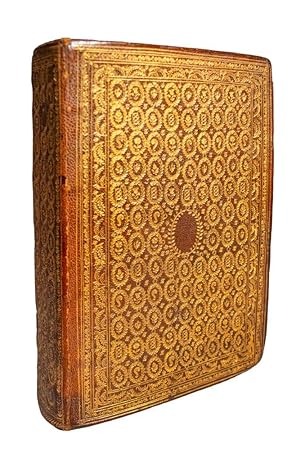
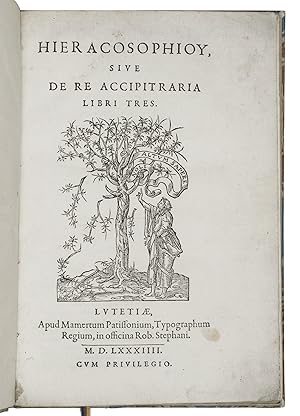

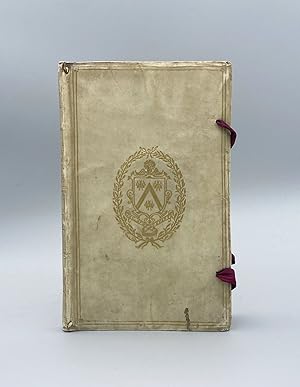
![Seller image for Slovo pokhvalnoe velikomu gosudariu Borisu Fedorovichu Godunovu [Eulogy to the Great Tsar Boris Fedorovich Godunov] for sale by PY Rare Books](https://pictures.abebooks.com/inventory/md/md31416751946.jpg)
![Seller image for [Greek title:] Epistolarum amplius mille ducentarum libri tres.accessit Latina.Iacobi Billii.Eiusdem Billii Sacrarum Observationum libri duo for sale by Bruce McKittrick Rare Books, Inc.](https://pictures.abebooks.com/inventory/md/md31763428177.jpg)
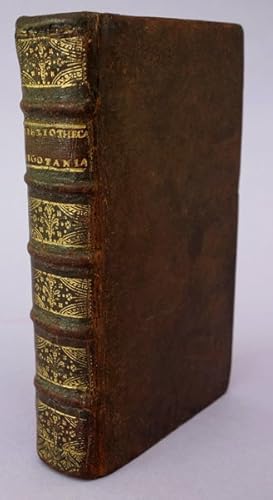
![Seller image for Rerum toto orbe gestarum chronica a Christo nato ad nostra usque tempora. Auctoribus Eusebio Caesariensi episcopo, B.Hieronymo presbytero, Sigeberto Gemblacensi monacho, Anselmo Gemblacensi abbate, Auberto Miraeo Bruxell.aliisq[ue]. Omnia ad antiquos codices mss.partim comparata, partim nunc primum in lucem edita . for sale by Bernard Quaritch Ltd ABA ILAB](https://pictures.abebooks.com/inventory/md/md30937231977.jpg)


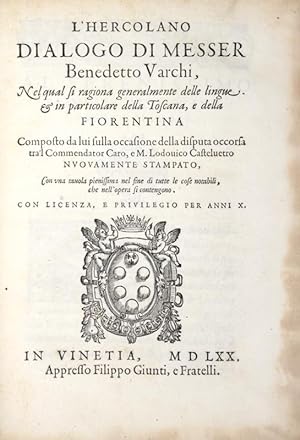
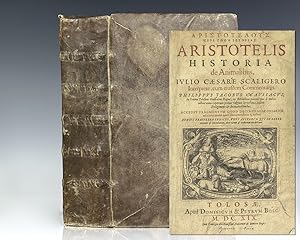
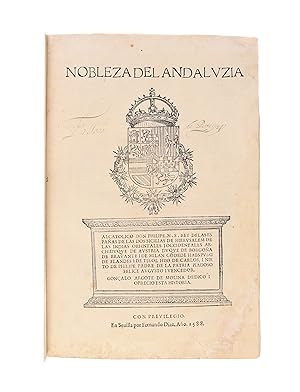
![Seller image for De Sancta Trinitate libri tres contra huius aeui trinitarios, antitrinitarios, & autotheanos [with] Id., Ad Jacobum Schegkium assertionibus sacris de Deo sese temere immiscentem et tribus ipsius de sancta Trinitate libris responsio. for sale by Symonds Rare Books Ltd](https://pictures.abebooks.com/inventory/md/md22760608450.jpg)
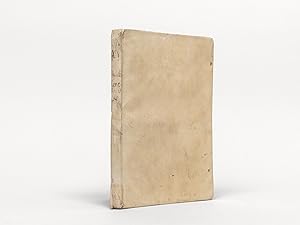
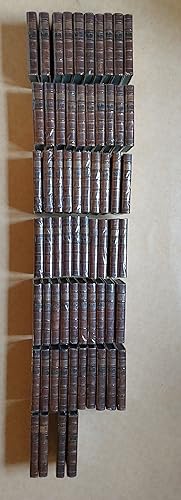
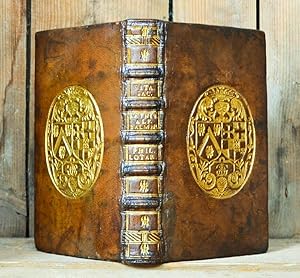
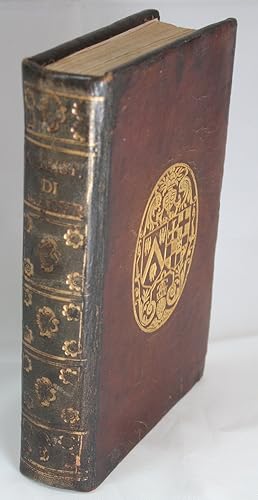
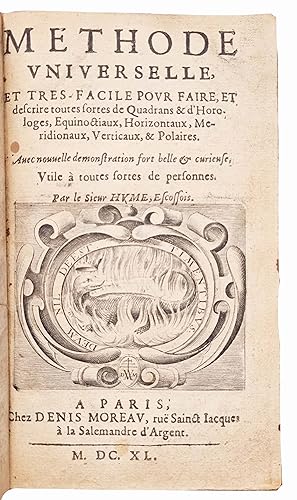

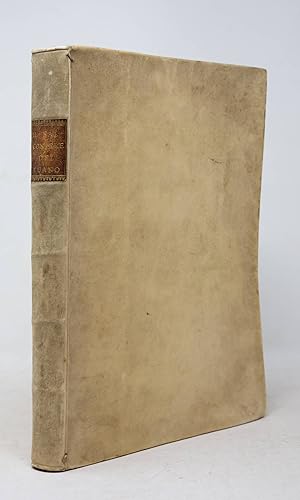
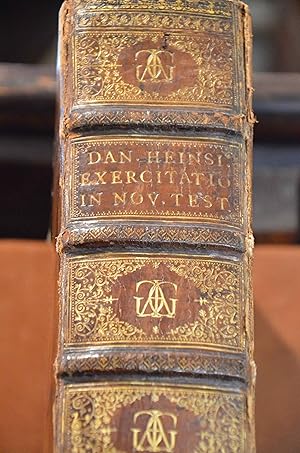
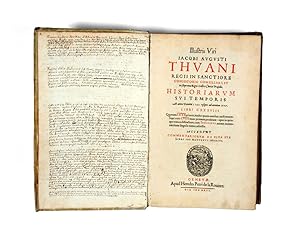
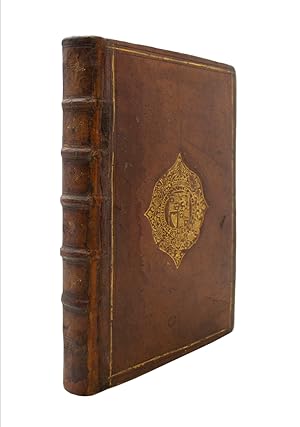
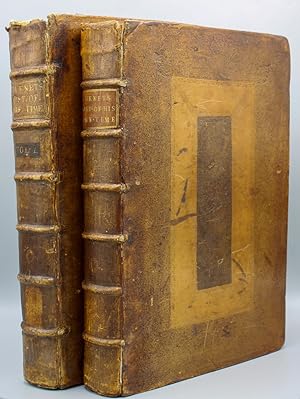
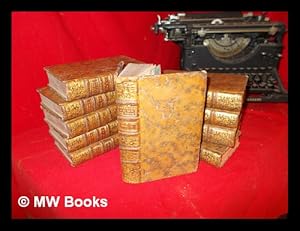
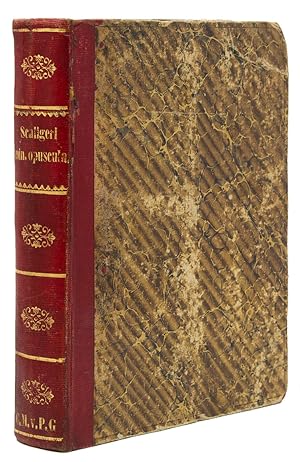
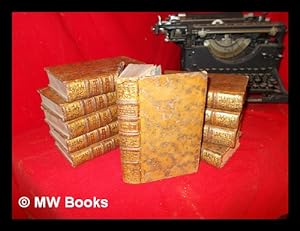
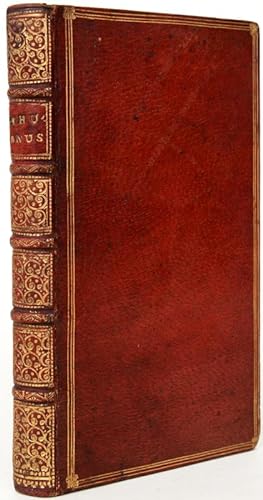
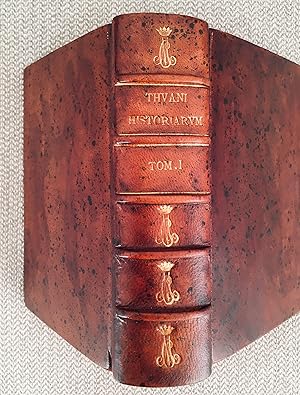
![Seller image for Plaidoyez dur le droict d'Aisnesse des gens d'Eglise [en l'espece pour Pierre Baron, demandeur, contre Antoine Baron et Anne Vaide, sa femme, defendeurs] for sale by Michael Laird Rare Books LLC](https://pictures.abebooks.com/inventory/md/md22779253465.jpg)
![Seller image for Le théâtre des antiquitez de Paris, où est traicté de la fondation des Eglises & chapelles . de l'institution du parlement, fondation de l'université et colleges, & autres choses remarquables . Par le R.P.F. Jacques du Breul . Augmenté en cette édition d'un supplement . depuis l'année 1610 jusques à present ; Supplément des antiquitez de Paris. Avec tout ce qui s'est fait & passé de plus remarquable depuis l'annee 1610, jusques à present. Par D.H.I. - - - - [SUIVI DE - BOUND WITH] Supplement des Antiquitez de Paris for sale by Librairie Lalibela](https://pictures.abebooks.com/inventory/md/md31847050889.jpg)
